The Fed contributed to the financial crisis, keeping interest rates too low for too long. I give them credit for responding and stabilizing the economy and the financial sector during the crisis. But then they tried to do too much with quantitative easing that went on forever, just dramatically exploding their balance sheets.
The U.S. government has a technology, called a printing press (or today, its electronic equivalent), that allows it to produce as many U.S. dollars as it wishes at no cost.
If unlimited borrowing, financed by printing money, were a path to prosperity, then Venezuela and Zimbabwe would be top of the growth tables.
The Nasdaq bubble and crash were followed by the real estate bubble, then subprime crash, which led to the unprecedented printing of trillions of dollars in an attempt to prevent a global depression.
QE OR THE MONETARY HAIL MARY PASS
As the 2007 crisis unfolded, the policy options facing decisionmakers were grim. Housing prices were collapsing, mortgages defaulting and the financial sector crumbling. These may all have been fine, necessary and overdue corrections, but for the fact that a financial crisis overshoot can all too easily spin out of control. The specter of a Great Depression, triggered by a run on banks, loomed all too close for comfort.
Obviously, a strong fiscal stimulus and nationalization of the banks was the first port of call. But, as we have seen, in many countries fiscal policy was a compromised option, not to mention the legal (Maastricht Treaty and others) and political (polarization and legislative dysfunction in the U.S.) constraints that put a timely, fully effective, traditional fiscal action out of reach. Nevertheless, and fortunately, a central bank financed fiscal stimulus led by the U.S. was put in place.
As the crisis unfolded, governments threw in the last fiscal stimulus they possibly could and rushed to coordinate the rescue of the banking sector. As a result, the debt-to-GDP ratio quickly reached historic highs not seen since World War II. Simultaneously, as usual since the mid-’80s, central banks entered into a monetary stance that was as accommodative as possible and cut interest rates. But having already set short-term interest rates at a low level to start with, the interest rate cuts were not large and rapidly hit the wall of 0% real interest, which is where monetary policy stops making sense. Below 0%,80 it technically becomes cheaper to hold cash than to hold bank deposits or government bonds. Yes and no. Companies cannot transact in millions of dollars using cash. There was a TSY auction where bonds sold at negative interest rates.
At that point, paradoxically, the very policy meant to help the banks, lowering interest rates, creates the risk of an implosion of the banking system with massive withdrawals leading to a full-scale run on the banks. Observed in the West in the ’30s and in Japan at the beginning of the ’90s, this individual hoarding of cash creates a liquidity crunch for banks and rapidly erodes both the monetary multiplier and the monetary aggregates. Distrustful of failing financial institutions people line up for withdrawals and buy safes to keep them at home. To meet these withdrawals, the banks rush for cash by selling off any liquid assets in a tumbling market. The Telegraph
Lower baseline interest rates created another problem. The lower the interest rate is to start with, the more ineffective interest rate cuts are, in an unsurprising reduced marginal effect. Paying 1% or nothing on one’s debt has a lower effect than a drop from say 5% to 4%. A study from the central bank of Australia reviewing interest rate cuts in low interest rate environments summarized it well, if phlegmatically: “Both conceptually and empirically there is support for the notion that monetary transmission is less effective when interest rates are persistently low.” Reserve Bank of Australia
So, following decades of abuse of fiscal policy and mismanaged monetary policy, we stood on the brink of collapse with no sustainable traditional policy option to confront a meltdown of the economy and the financial markets. Even the creditworthiness of Western nations was put to the test. In the Eurozone, credit spreads81 for the peripheral countries reached new highs. Market distrust of government and banks was rampant – and justified.
It is in that context that the decision to rush into QE, first by the U.S. then the E.U. and Japan, has to be understood. It was a last, desperate measure to forcibly inject liquidity into the economy by massive acquisition of government bonds, and in some cases, even corporate bonds. This was, in terms of scope and symbolism, as drastic as the abandonment of the gold standard by President Franklin D. Roosevelt in 1933. It was a renunciation of orthodoxy, a leap into the unknown. Central bankers embraced the unthinkable to save the farm, even if all the consequences were not and could not be fully understood then – or even now. The Federal Reserve chairman at the time summed it up well: “The problem with QE is it works in practice, but it doesn’t work in theory.”
Ten years later, it can now be seen that QE has not fully worked in practice. While it successfully staved off a financial collapse, the policy has also exacerbated inequality and harmed the economy’s long-term growth prospects. Most alarmingly, it has been left in place for a decade, keeping interest rates near historic lows. As a result, when the next crisis hits, central banks will not be able to go any lower. In other words, after governments exhausted fiscal policy, 10 years of QE has now exhausted monetary policy as well.
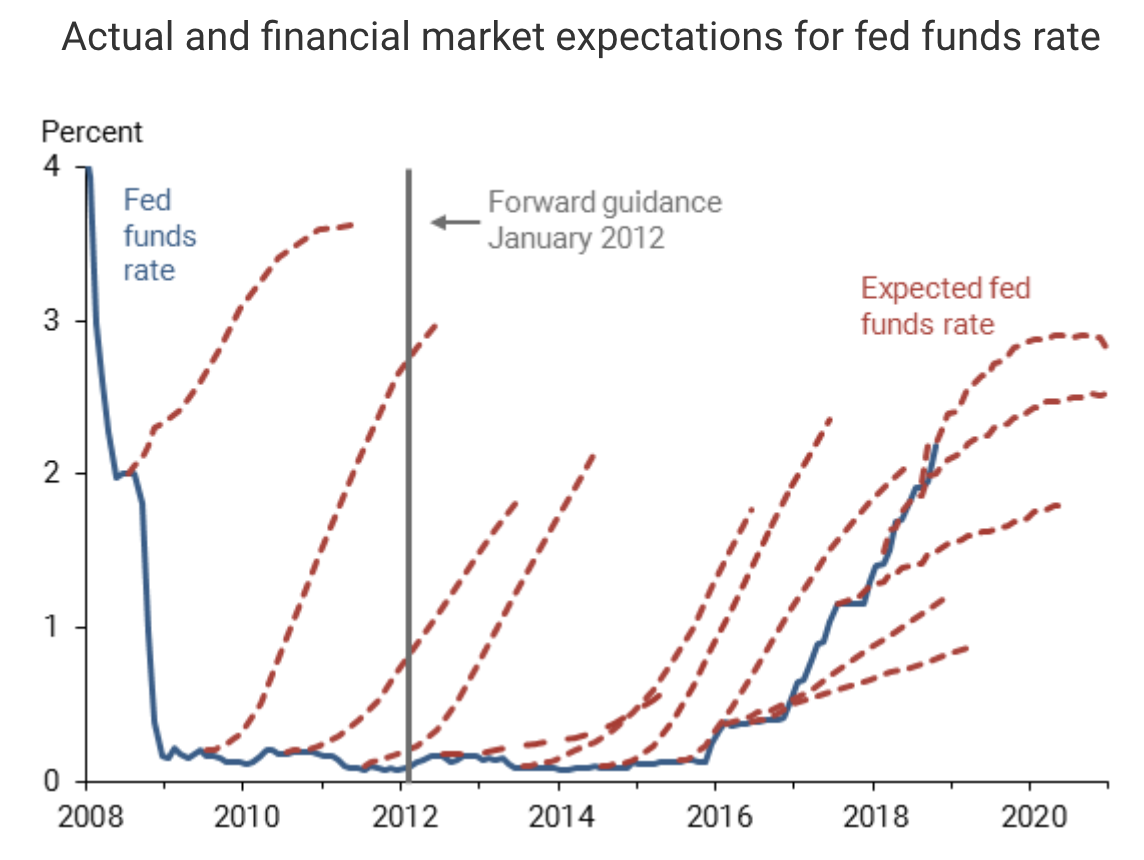
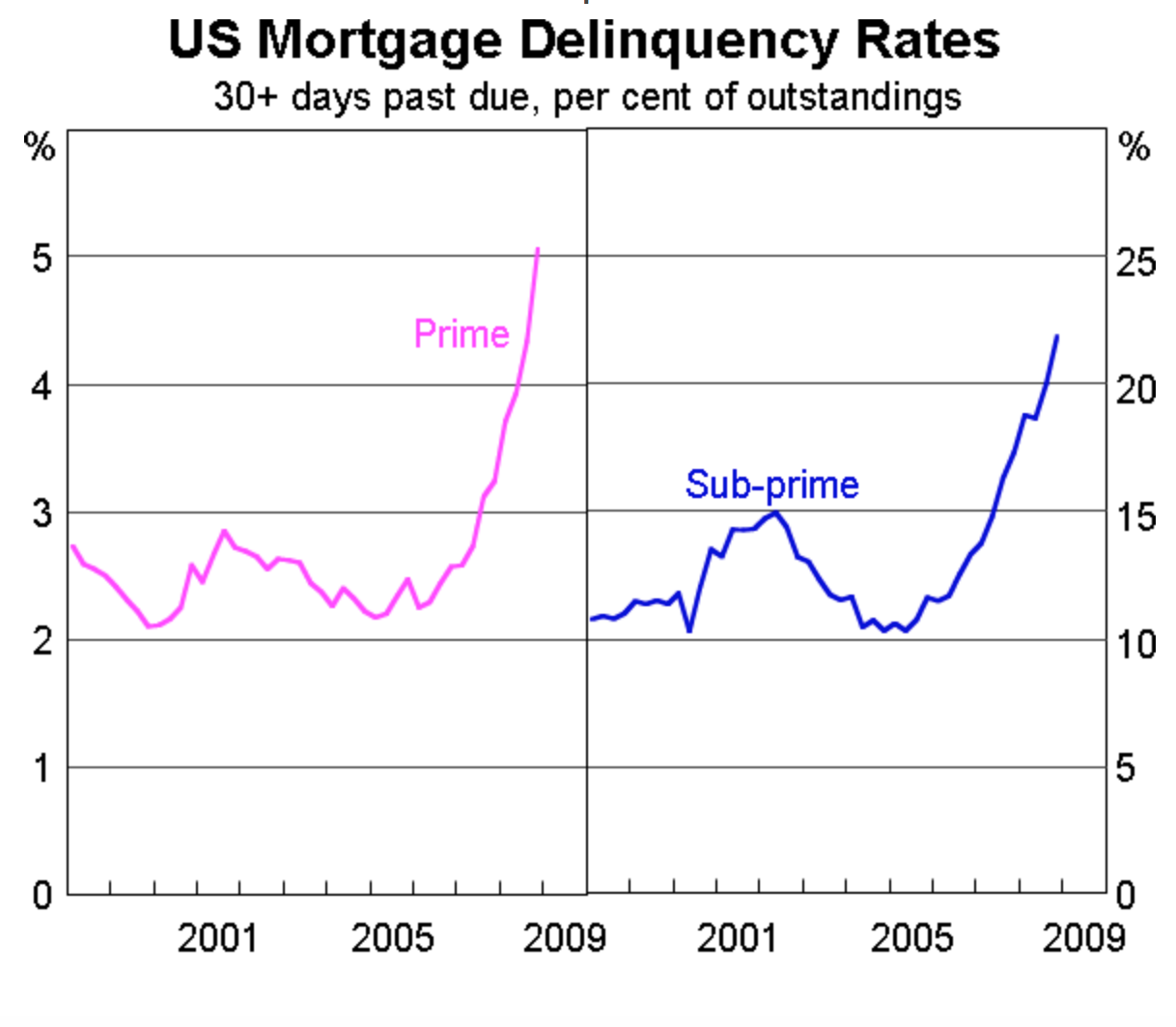
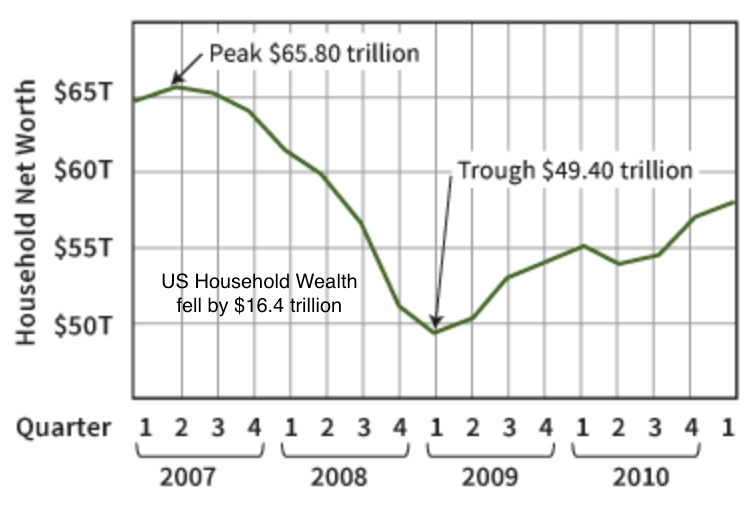
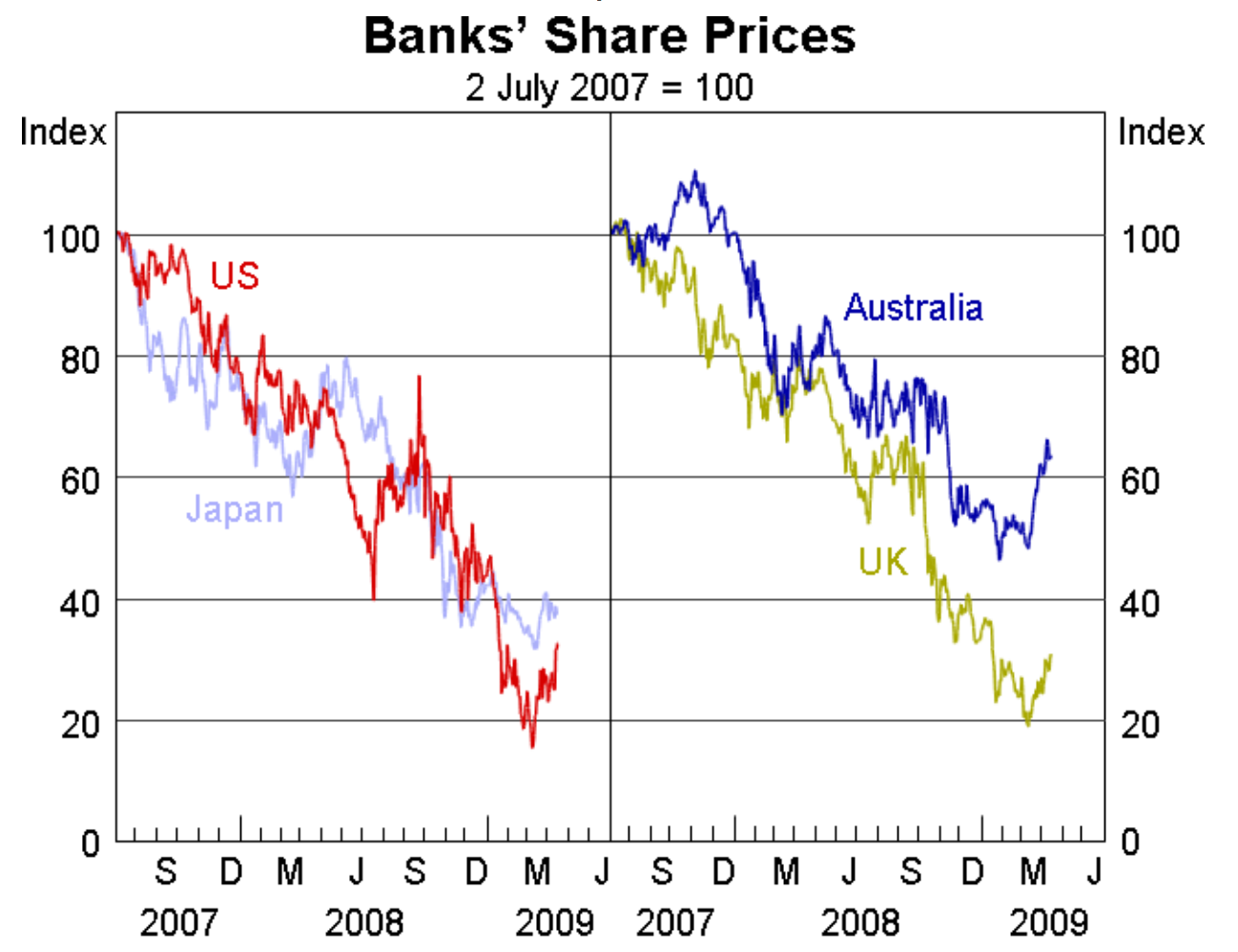
WHAT IS QE?
QE can best be understood as an attempt to push down the throat of the financial system money, any amount of money, until liquidity – and confidence – can be restored. In the process, it is also an attempt to “reboot” the economy by pushing up asset prices, reflating them. Such reflation, by creating a wealth effect, should then boost consumption, and ultimately, consumer prices.
To most economists, QE was a form of helicopter money, an old idea whose time had come Financial Times. The notion was first floated by the late economist Milton Friedman in 1969:
“Let us suppose now that one day a helicopter flies over this community and drops an additional $1,000 in bills from the sky, which is, of course, hastily collected by members of the community. Let us suppose further that everyone is convinced that this is a unique event which will never be repeated.” Friedman
Central banks direct money injections would force money to circulate more freely, spurring economic activity and inflation. Traditional Monetary policy relies on the banks transmitting to the real economy their lowered borrowing costs, but QE would also boost wealth and liquidity.
The mechanism for injecting money in the system is critical to QE. Several approaches could have been taken, and were to some extent tried. One could have given a lump sum of money to each citizen. Former Fed Chairman Ben Bernanke had previously suggested it could come in the form of a tax rebate financed through central bank purchases of government debt. In Singapore, the government successfully experimented with this, giving citizens money in their social security savings accounts. The money also could have been “lent,” in one form or another, to industrial companies, as was done in Korea.82 This was not the route most central banks took, probably on account of some combination of logistical convenience, legal hurdles, and the need for speedy action.
The major central banks, from the Fed to the ECB, the BOJ, and the BOE all proceeded, under various exotically named programs, to open market acquisition of debt, and various forms of lending to banks against outstanding fixed income assets on their balance sheets. Concretely, that meant that central banks “printed” money with which they acquired on the markets, or became exposed to by virtue of central bank guarantees, government bonds, government-backed debt, and even corporate debt. As a result, both the amount of money outstanding and the central banks’ balance sheets exploded. It is estimated that major central banks’ balance sheets have quadrupled since 2008 to $15 trillion, supporting the bond and stock markets in the process.
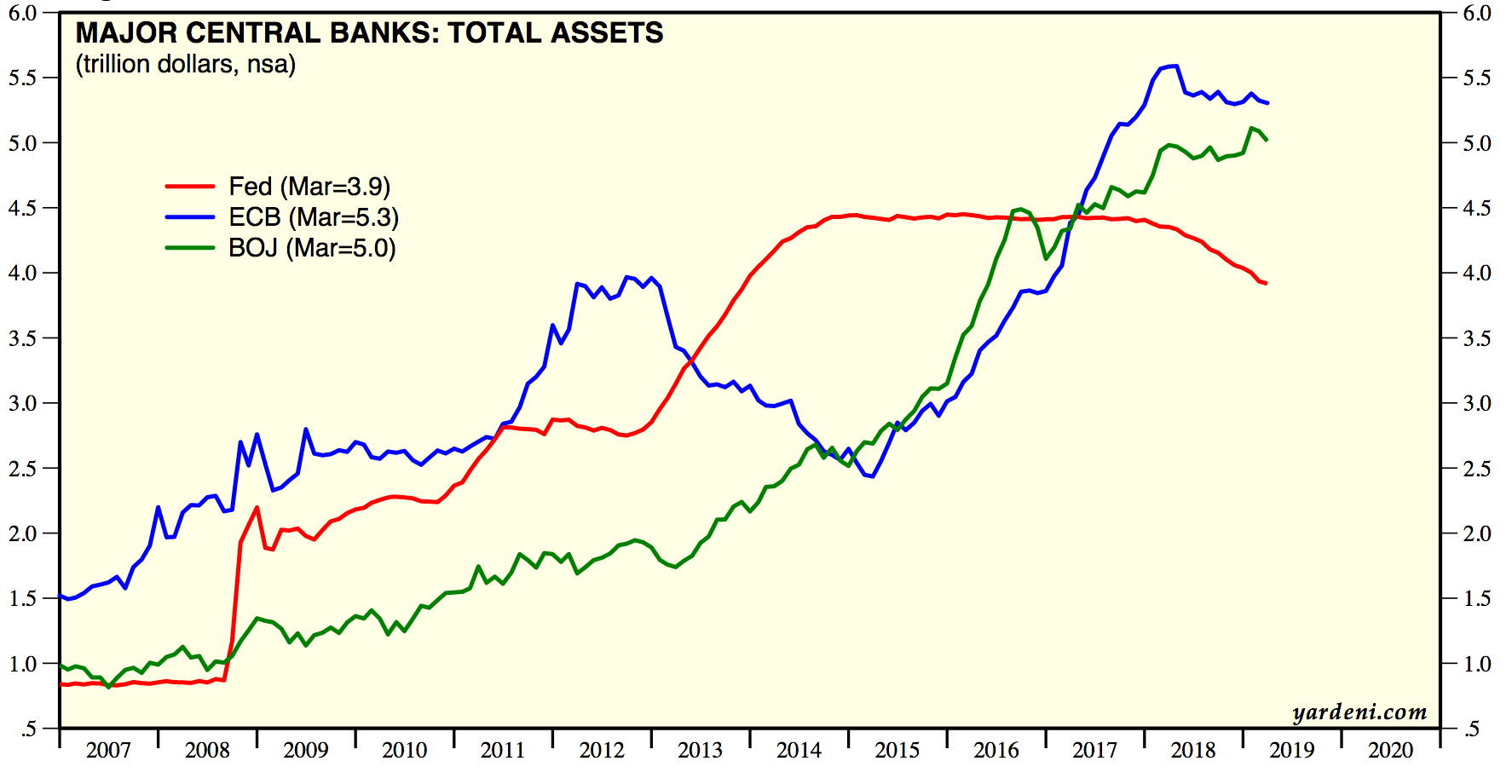
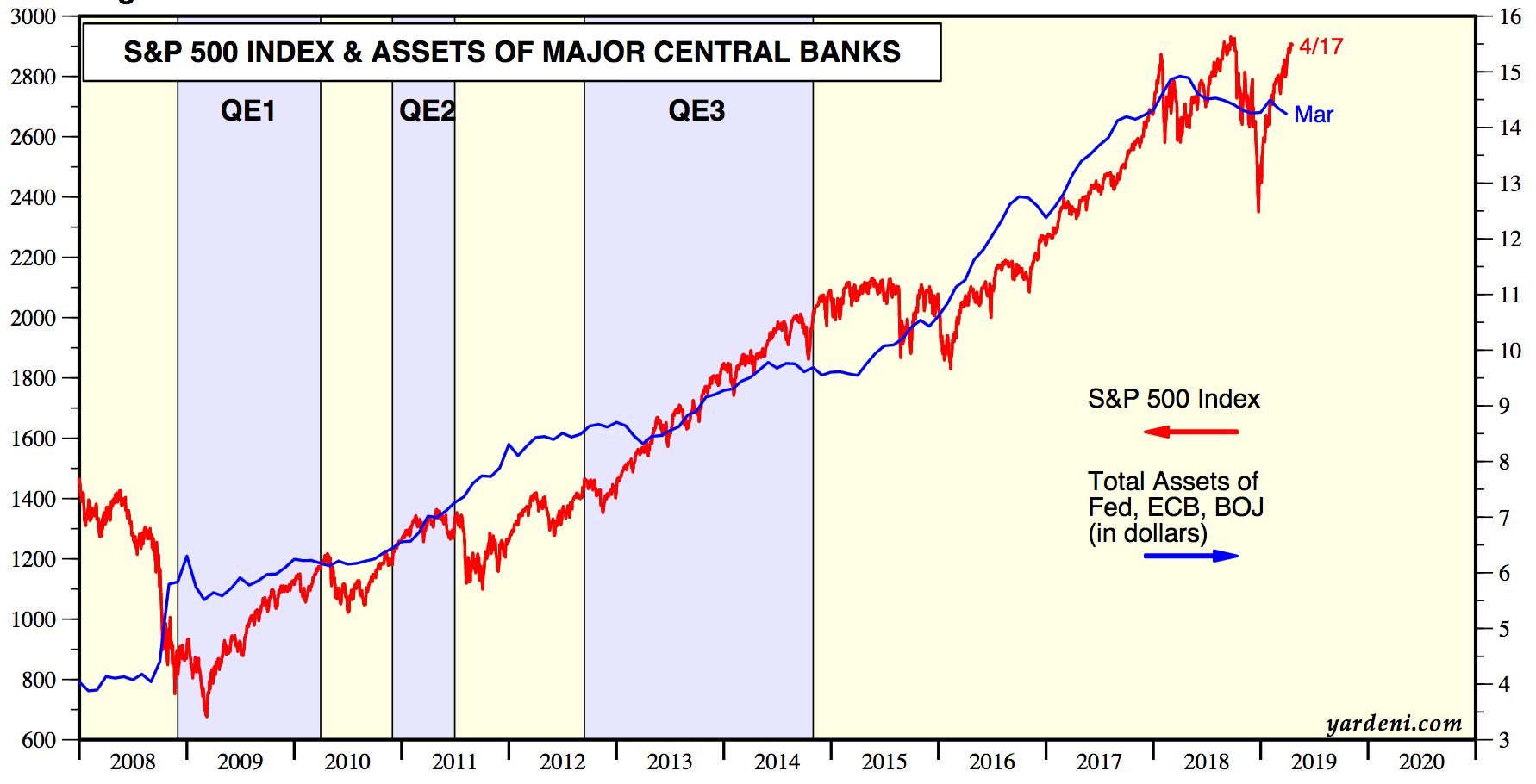
EARLY DOUBTS
The West’s various programs all ended up with national central banks purchasing large chunks of government debt. Having acquired up to a third of outstanding government debt, they had effectively financed government deficits and debt, dramatically reducing interest rates on the rest of this debt in the process.
This generated some uncomfortable questions about what QE really was. Was it not simply a monetary financing program, a bit of thinly disguised, old-fashioned money printing used to bail out governments desperate for financing? Central banks vehemently denied the obvious, but the German Constitutional Court ruled that the ECB decisions governing “the asset purchase programme violate the prohibition of monetary financing and exceed the monetary policy mandate of the European Central Bank”. Bundesverfassungsgericht
Further, Friedman had warned that rational consumers were likely to save their windfall gains. For him, if you perceived it as a one-off, if your future earnings prospects were not improved, you would simply not consume the helicopter money, or perhaps consume only a small fraction. Economic activity will not be spurred by monetary magic.
What about if QE was extended, prolonged over ten years, as it was. Would expectations be changed? If consumers perceive that an endless supply of money will be given for free, money will no longer have any value. Consumers will switch to new currency forms, whether foreign currency, Bitcoin, or old-fashioned commodities. Confidence will collapse, leading to further reductions in consumption. Money would no longer serve its role as an essential price signaling mechanism; its role in the social contract would be fatally undermined.
The monetary magic of QE is no answer to longstanding structural issues. The deflationary cycle signals that global overcapacity can only be absorbed at a lower cost, where it will find renewed demand, or through a new cycle of innovation. Trying to tamper with this adjustment will only result in misallocation of resources, itself inexorably leading to further bad loans, default, and a new credit crisis down the road.
Nobel laureate Robert Shiller, who had forewarned of these asset and real estate bubbles, expressed his doubts: “Negative interest rates … can’t be a fundamental way to respond to recession. Rather than throw money from the helicopter, it is much better for policy makers to create an environment for business people to increase investment based on animal spirits.” Shiller
QE ACHIEVEMENTS AND FAILURES
AVOIDING A MELTDOWN AND PROVIDING LIQUIDITY
QE initially saved the day. In conjunction with the last-ditch fiscal stimulus and government guarantees, it stopped the financial crisis in its tracks. As liquidity flowed in, long-term interest rates decreased while market valuation stabilized and then soared. The specter of a new great depression caused by a financial meltdown withered away. In the U.S., the Lehman and AIG bankruptcies were contained, and the defaulted positions progressively unwound.
Similarly, a few years later, a European sovereign debt crisis was avoided through a rebooted European QE. The rapidly rising credit spreads on the bonds issued by governments on the EU’s periphery following the Greek debt restructuring were contained and progressively reversed as the ECB vowed to do “whatever it takes.” QE not only tamed the Eurozone’s impending sovereign debt crisis, but it also supported financial institutions’ balance sheets. This was critical in countries with high levels of non-performing loans, such as Italy, that simply could not afford to bail out their banking system within the European system. QE, as a last-ditch emergency tool, has twice prevented a systemic collapse.
Yet QE also proved its limits. A Federal Reserve Bank of St. Louis reviewed these “massive central bank purchases.” It recognizes that QE was helpful in providing liquidity to financial markets and temporarily increasing some asset prices. But its impact on providing liquidity declined with the intervention. Critically, it observes that “There is no work, […] that establishes a link from QE to the ultimate goals of the Fed: inflation and real economic activity.” In fact, “casual evidence suggests that QE has been ineffective in increasing inflation.” Federal Reserve Bank of St Louis
So, QE avoided the worst and bought time at a critical juncture, postponing the day of reckoning. It successfully injected liquidity when needed, and pushed up financial valuation in the process. But then it was ineffectively prolonged in an effort to “jumpstart” the economy and inflation. It continued to be used and abused (QEII, QEIII), until 2016-2018, when the Fed started to progressively wind it down and the European Central Bank decreased its intensity, and finally announced it would suspend its net acquisition.
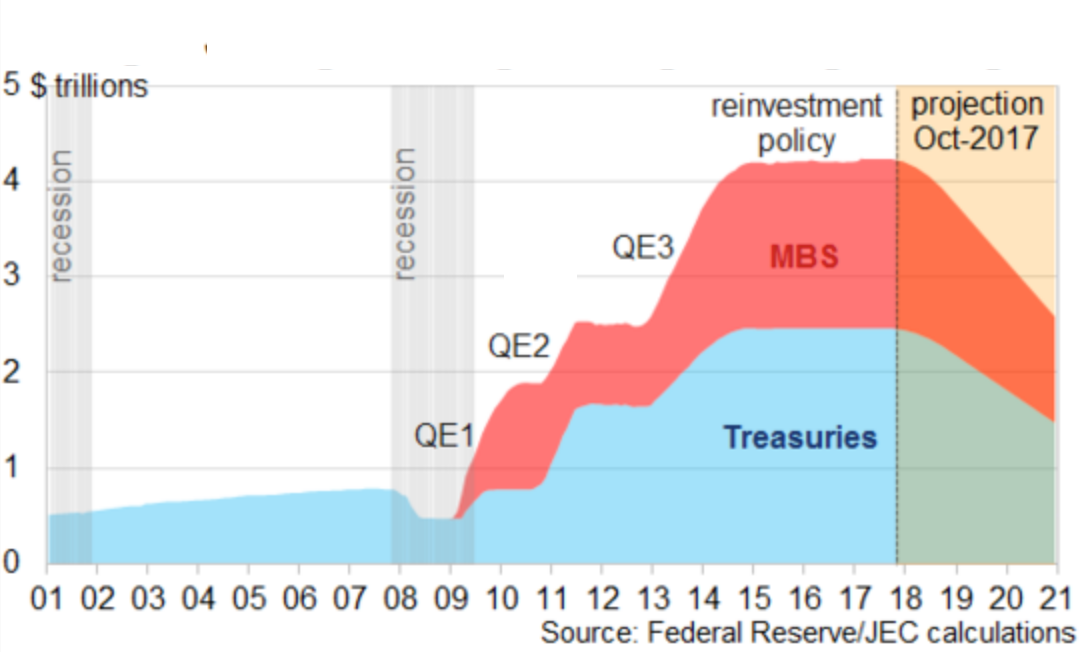
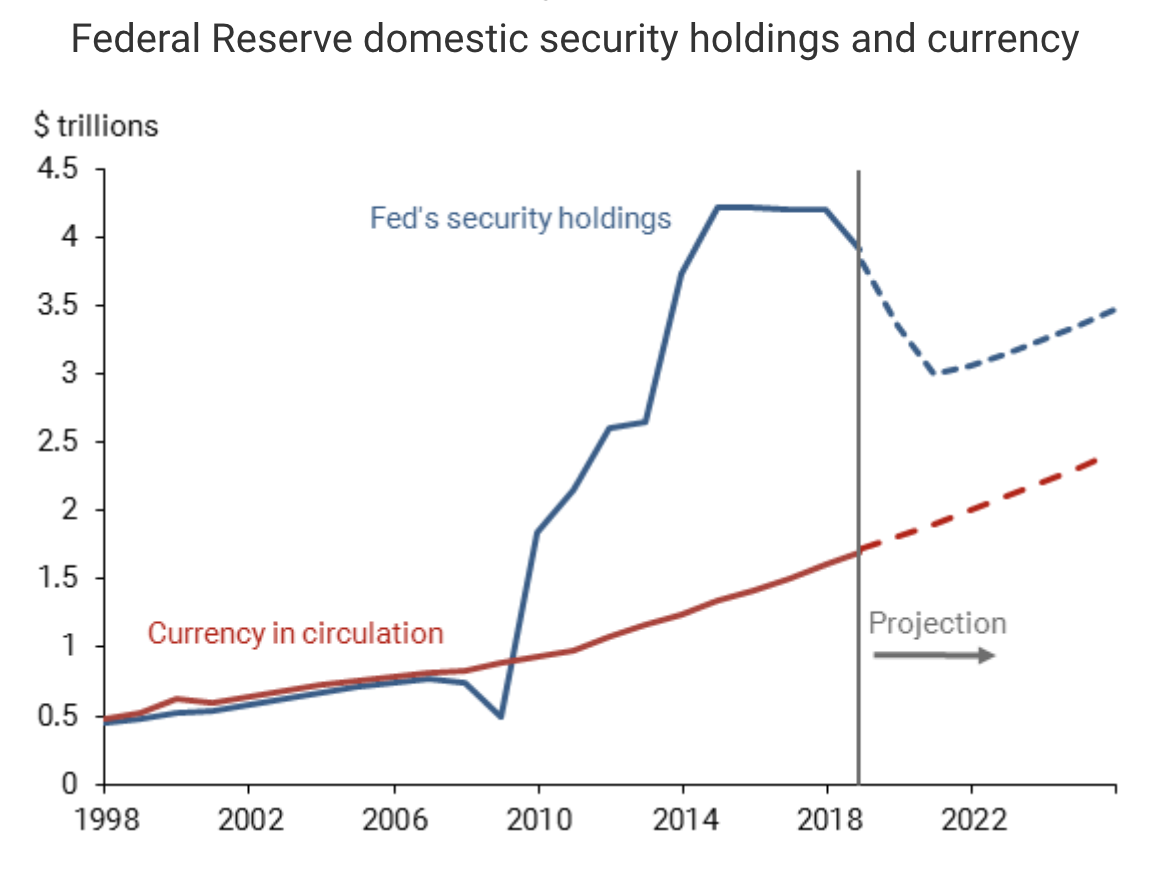
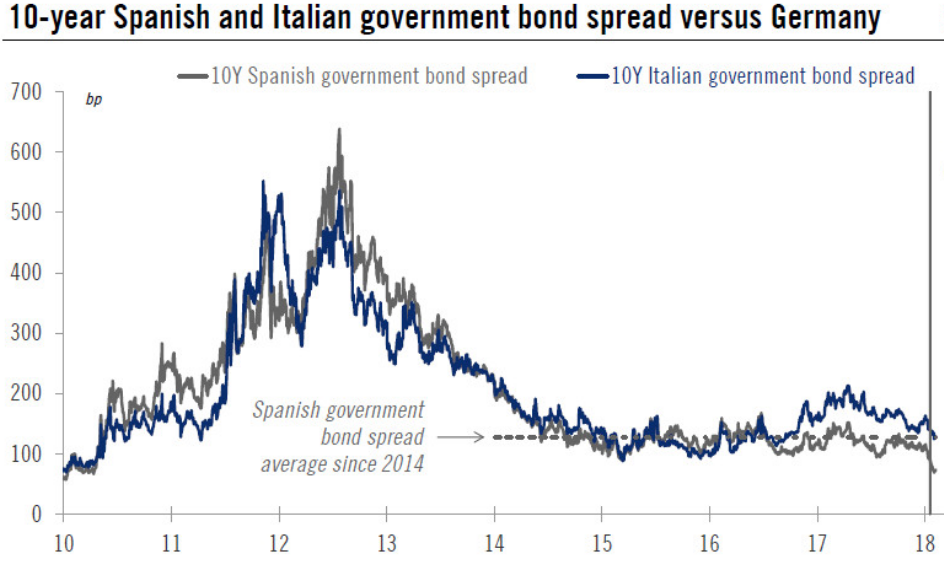
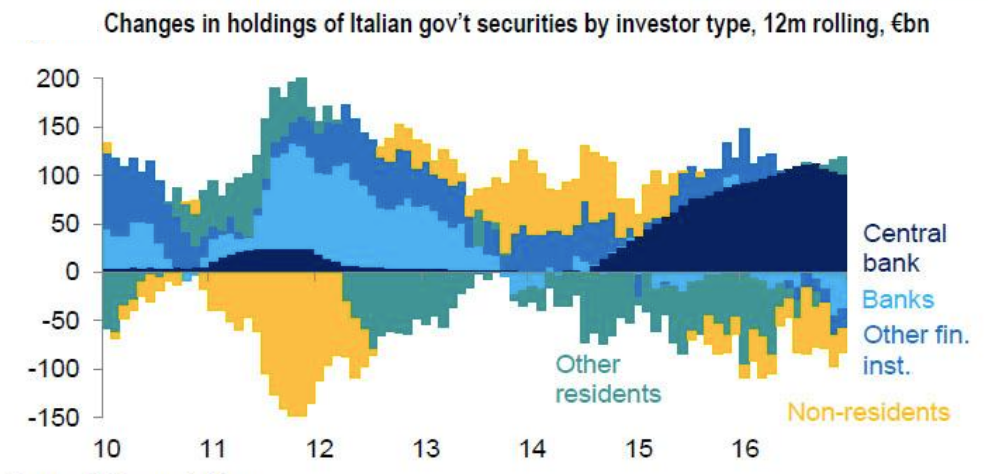

QE AND CONSUMER INFLATION
The traditional view of inflation is that it is a monetary phenomenon, as described by Friedman. Famously, more money printed for a given level of production should lead to inflation, while destruction of money for the same amount of goods transacted should lead to deflation. In theory, QE monetary expansion should thus have triggered massive inflation. Only it did not work.
Janet Yellen, the formidable economist and former Fed chair, famously described the current low level of inflation as a “mystery”. This is not comforting. With QE having multiplied the amount of fiat money issued by central banks in just a few years, it is fair to wonder why it did not trigger, after preventing a financial system meltdown, some massive inflation. The technical answer is that the money created has ended up, full circle, back on the books of the central banks. The more fundamental answer is that QE created a wealth increase for the wealthiest, who consume little of their revenue, while the middle class and the neediest largely failed to reap any benefit, and thus failed to consume more and push prices up in the process. Janet Yellen
The mechanics of QE meant that the central banks, rather than printing money for goods and services provided to the government, as in most hyperinflation stories of bankrupt governments, printed money to acquire, at increasing price, financial assets, overwhelmingly the very debt of their governments. QE was thus from the start a somewhat disconnected financial world, rather than “real economy”, affair, and rightly so, as its primary aim initially was to prevent a financial meltdown set off by a potential run on the banks or the EU’s weakest states.
Financial actors though, finding themselves overwhelmed by the newly minted money, did not proceed to spend it or consume it, but rather either reinvested it in increasingly expensive financial assets, hoarded “real assets” alternatives such as real estate, or simply deposited it back at the central bank. Higher deposits, rather than higher “real world” lending, meant that the money multiplier83 did not kick in. So, if the strict monetary aggregate did increase massively, the expanded aggregates were in comparison only marginally affected. In a broad sense, incorporating the banking world, there was little money creation, just wealth-hoarding asset price inflation.
The mystery however can only be fully explained by taking into account one particularly disruptive aspect of QE as it was implemented in the Western world. The effects of QE were not uniformly distributed. By inflating asset values, it trickled down wealth gains to the wealthiest. In the UK, according to the Bank of England, it has been estimated that QE brought gains of 1,000 pounds to the bottom decile and 400,000 pounds to the top decile.
This reflects the simple fact that the benefits of these asset price increases accrued to the wealthiest. In the U.S., the top 10% of households, after all, hold close to 80% of the net wealth OECD. But the wealthiest consume the smallest portion of their income, having a higher propensity to save. This is particularly the case when the gain is found to be exceptional, rather than recurring, as is the case with QE. As for the middle class, its income has been capped for decades by cheap foreign imports and an automation wave, neither of which is changed by a monetary phenomenon like QE. As a result, only a small fraction of the newly created wealth found its way into consumption, and when it did, it was limited to luxury goods and real estate through higher rent. In 2017, Coutts reported that a “cost of living well” index, a measure of inflation for luxury consumption, went up 6.2%, while in the corresponding period the UK’s consumer price index rose merely 2.9%. QE price inflation worked, but only for the wealthiest. Thus, the mystery is solved. Simply put, because of the unfair and unequal wealth distribution generated by QE’s injection mechanism, little demand and consumer price inflation were created. Coutts
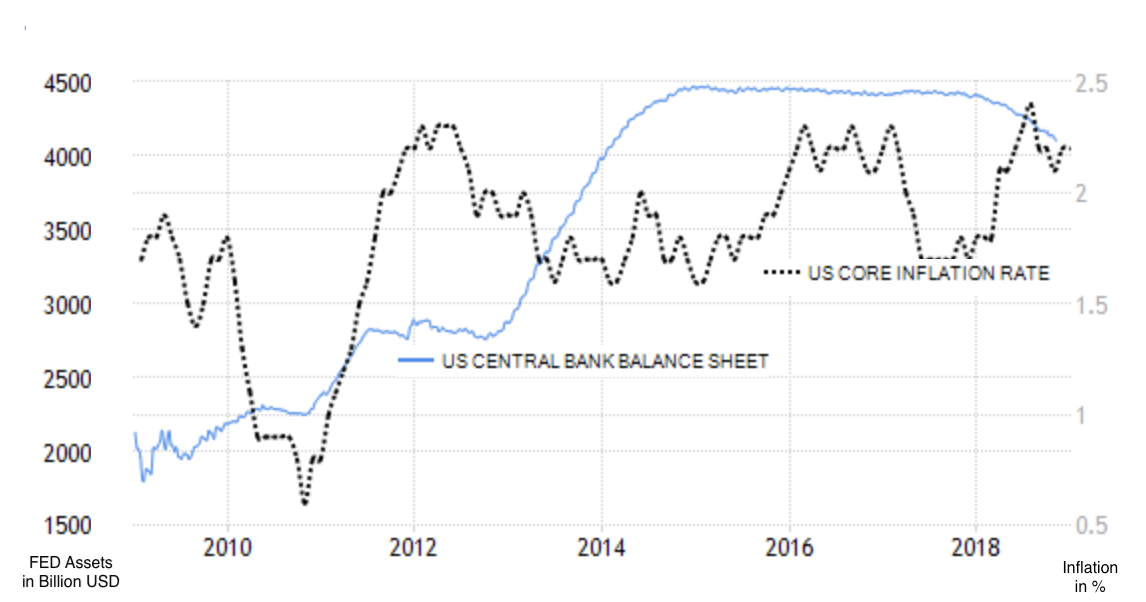
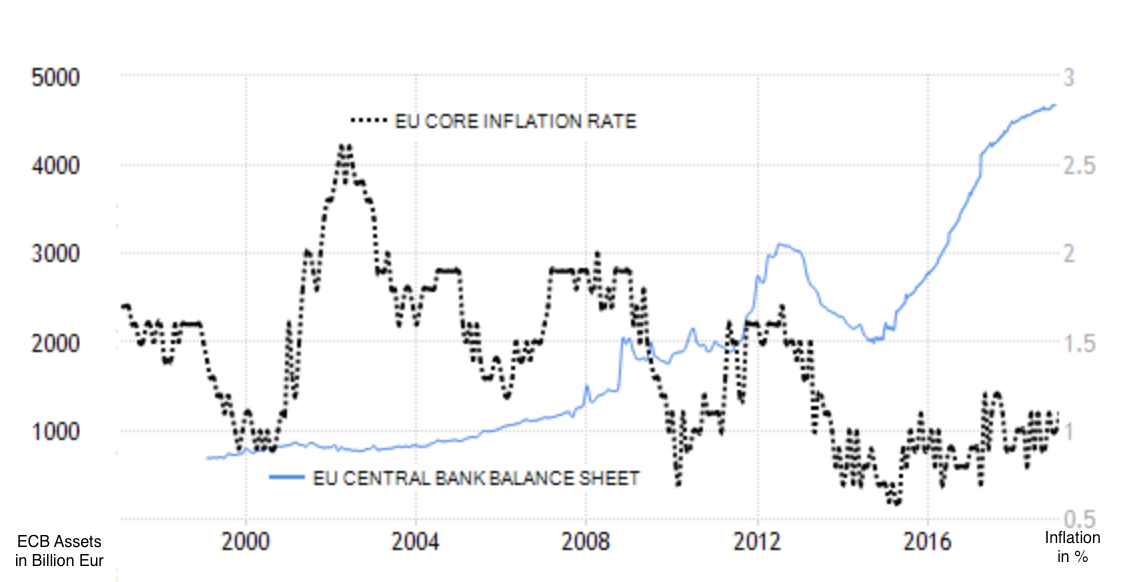
QE AND ASSET INFLATION
But by bringing massive nominal money printing, QE did create inflation, albeit of a non-traditional kind. It created asset inflation, that is that the prices of all the investible assets have been increased beyond their normal level. This happened quite mechanically. As the central banks bought government bonds, and other securities, these assets were withdrawn from the investable domain. Investors, unwilling to spend their gains, looked for ways to reinvest the liquidity generated by their sales to the central banks. Logically, they bought among the remaining assets. This pushed these assets’ prices up, be it securities, shares, corporate bonds, government bonds, or real investable assets such as housing. The housing market in particular became a means of hoarding money, making real estate a financial asset rather than an economic one.
From 2008 to 2015, the nominal value of the global stock of investable assets increased by about 40 percent, to over $500 trillion from about $350 trillion. Since the start of QE, the stock exchange entered its longest bull market on record, with the S&P growing by over 300% in 10 years (creating $18 trillion of paper wealth along the way). This was a logical outcome, as not only was money injected through the acquisition of bonds, but indeed the stock of government bonds (and others) available for purchase by investors decreased. There was more money to be invested in fewer securities, and the price of stock shares logically went up as a result of spill-over demand. This of course raises issues, as, for instance, 84% of shares in the U.S. are owned by 10% of the population. The growth of the money supply, along with lower interest rates, also reduced interest rate payments, boosting risk-taking and feeding the reflation of housing prices. The increase in real estate prices, which has been largely concentrated in the most expensive areas, has had a similar wealth concentration effect. While it is true that about two-thirds of U.S. houses are owner-occupied, the distribution in the value of those houses is far from equal. Indeed, the most expensive 20% of properties (sometimes multiply owned by a single owner) account for over 50% of housing wealth. Not surprisingly, this has, according to economic historian Mortitz Schularick, been “the decade in which wealth inequality has increased the most in U.S. history.” With housing a more important asset than securities in Europe, the same holds true on the ‘old continent’ but to a lesser extent CityLab.
Consumer price inflation effects are well known. It erodes savings and the value of fixed earnings as prices rise. As economic actors fail to keep up with the price changes, the wrong pricing signals generate misallocation of resources. Companies may unknowingly sell at a loss, while workers repeatedly have to ask for wage increases just to keep up. The true losers, though, are people with savings, which see their value in real purchasing power diminished. John Maynard Keynes famously said that inflation is a way for governments to “confiscate, secretly and unobserved, an important part of the wealth of their citizens.” Critically, inflation creates much social tension: “While the process impoverishes many, it actually enriches some. The sight of this arbitrary rearrangement of riches strikes not only at security, but at the confidence in the equity of the existing distribution of wealth.”
Asset inflation, it turns out, is remarkably similar. First, it impedes creative destruction by setting a negative long-term real interest rate. This allows companies that no longer generate enough income to pay a positive return on capital to continue as usual rather than being restructured. Thus the much-noted growth of zombie companies, which are inefficient but just viable enough to avoid bankruptcy, is one consequence of asset price inflation Bloomberg.
Second, it also generates artificial winners and losers. The losers are mostly found among the aging middle class, who, in order to maintain future consumption levels, will now have to increase their savings. Indeed, the savings made by working people off stagnant wages effectively generate less future income because investible assets are now more expensive. The older the demographics, the more pronounced this effect. Germany, for instance, had a contraction of nearly 4 percent of gross domestic product in consumer spending from 2009 to 2016. No wonder consumer prices are not rising in a QE environment. The initial winners are the wealthy, people with savings at the beginning of the process, who saw the nominal value of their assets skyrocket. But, as with consumer inflation, the biggest winners are states, which now own though their monetary authority a large part of their debt, effectively paying interest to themselves, and at a much lower rate at that. When all is accounted for, asset inflation is a monetary tax.
The most striking similarity though is to the social disruption and political unrest caused by previous arbitrary monetary changes. In the ’70s, workers were striking to bargain for wage increases in line with price increases. Today, the impoverished middle class, whose wages have been on a declining trend for decades, is increasingly angry at society’s wealthiest members. It perceives much of their recent wealth to be ill-gotten, not resulting from true economic wealth creation, and seeks social justice through populist movements outside of the traditional left-right debate. The QE monetary disruption acted as a final trigger for the protest votes that have been observed in the Western world.
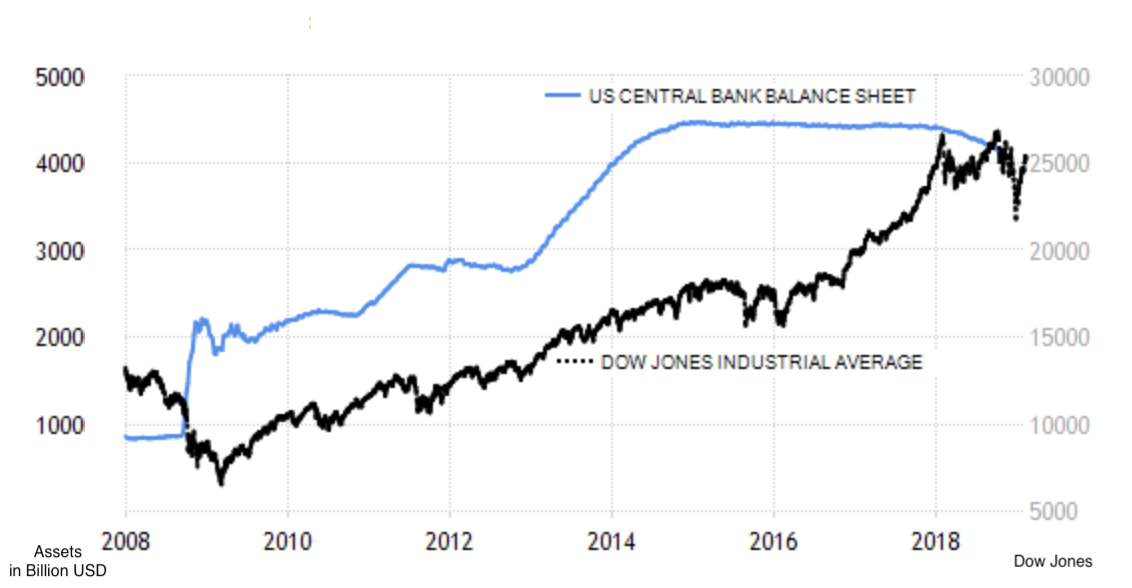
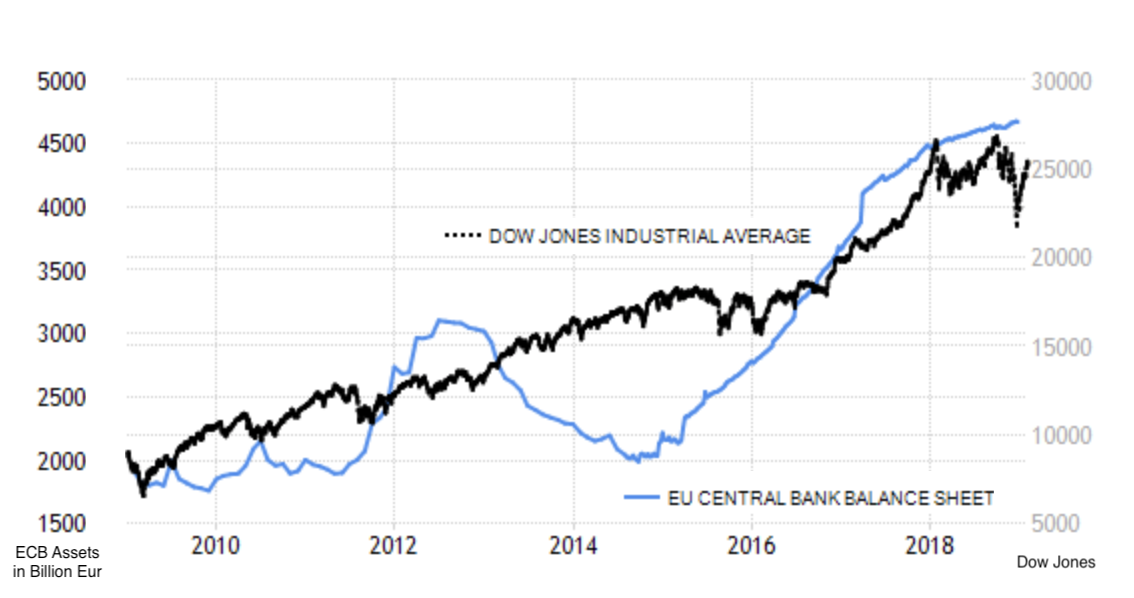
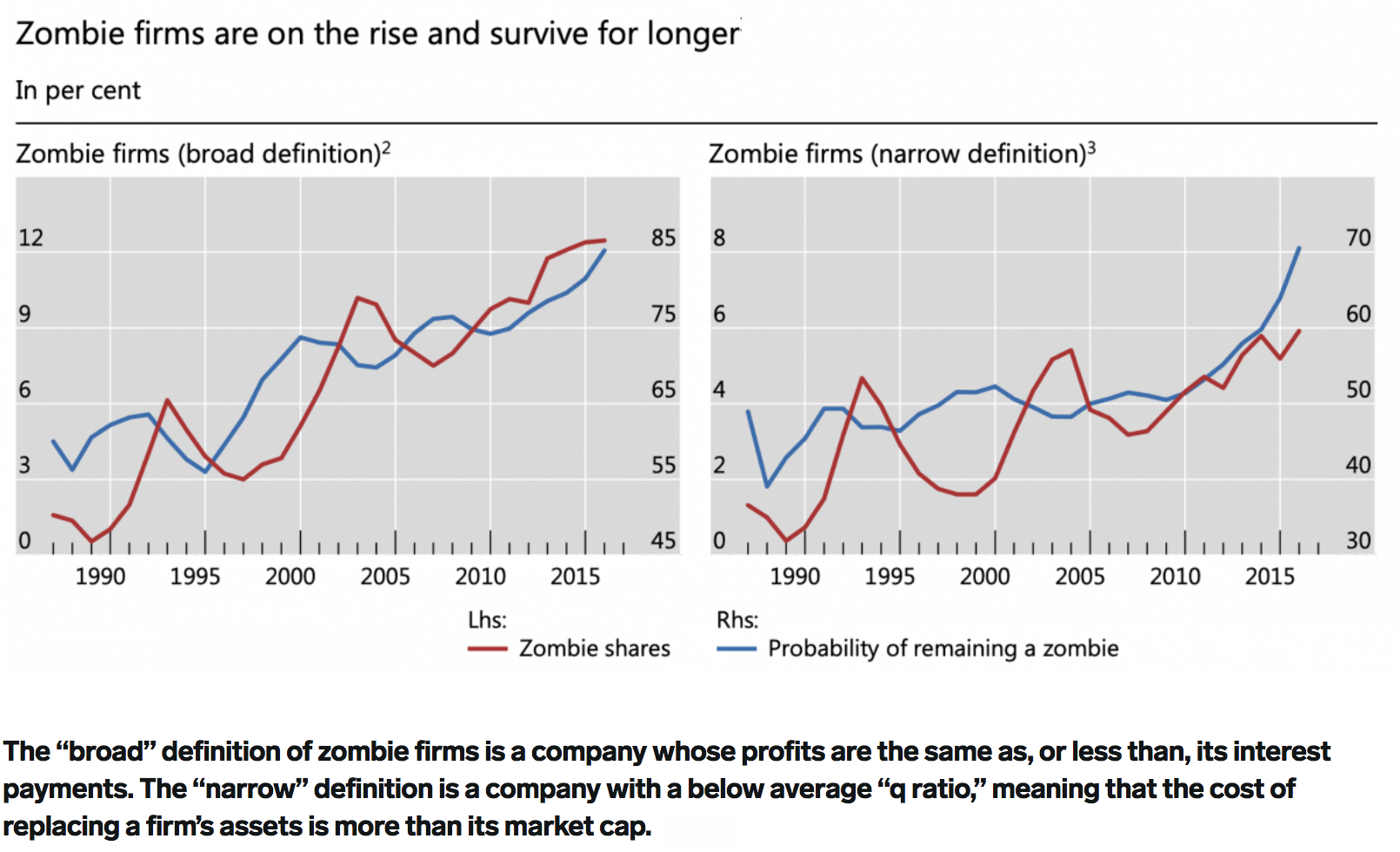
SOCIAL CONSEQUENCES OF QE
Historically, massive changes in monetary policy have coincided with critical political changes. In this regard, QE was no different, with the concomitant rise of populist movements and their concerns about wealth inequality. Indeed, central banks have recently tried to fend off charges that their actions have exacerbated inequality. Independent
But the data is damning. A good example is given by the Bank of England,84 which has tried to assess the distributional impact of monetary policy easing using advanced data modelling techniques. In 2018, it published a study that sheds light on both what has actually taken place, and how oblivious policy makers remain to what has taken place. Interestingly, while the report claims that nine years of asset purchases that pumped 375 billion pounds ($527 billion) into a faltering world economy didn’t widen inequality, its very results demonstrate the opposite. Bank of England
While the data does shed light on the impact of QE at the household level, it is not the exoneration the BOE seems to suggest. “Whatever the marginal impact of the extraordinary period of accommodative monetary policy on inequality, it was not associated with an overall increase in summary measures of inequality,” says the BOE report. That is true: If you net out the various effects of the period of central bank easing, the result is only a marginal change in inequality.
The problem is, not all the effects had an equal impact on the social and political environment, and so aggregating them makes no sense at all. The BOE doesn’t have to appreciate this nuance – its job is to stick to the inflation target – but policy-makers do, because it is their job to offset the distortionary impact of QE. So far, that’s not happening.
The study assesses the impact of monetary policy on inequality, mainly between 2008 and 2014. That was the period of quantitative easing that saw interest rates plunge toward zero and the BOE expand its purchases of financial assets. The BOE considers the impact on both income and on wealth (total assets, including housing) and the effect across wealth deciles and age groups.
One finding was that young people found their income disproportionately bolstered by QE, while older people saw interest on their savings stagnate. However, as the data shows, older households experienced a greater bump up in net wealth, in particular with QE steadily supporting housing prices. Those with the means took advantage of low-interest loans and ploughed any QE dividend into financial assets or real estate; those who already were owners and mortgagors refinanced on the cheap.
The overall marginal impact of monetary policy on wealth inequality was small, the bank sums up. But that depends on which impact you look at. If, in percentage terms, the wealth of the poorest may have increased more, this is from a deceptively low basis. The absolute terms are damning: According to the BOE, the wealth of the top 10 percent of wealthiest households has increased because of QE by close to 400,000 pounds, while the poorest 10 percent increased by a few thousand pounds at best.
Further, the combined income and wealth effect of monetary policy has overwhelmingly favored of the middle-aged and elderly, particularly those over 50. It was inevitable with quantitative easing that the elderly would see their interest income fall, but their total assets were preserved as real estate prices appreciated. The BOE study bears this out. Young people, by contrast, may have held onto their jobs, but they saw the price of home ownership rise out of reach, creating what is now referred to in Britain as “Generation Rent.” In other words, not only did the poorest benefit far less, but the dreams of the youngest to build a stake in society were pushed further away. Indeed, home ownership turned out to be a deciding factor in the 2017 elections that saw the Conservative government lose its majority. QE widened the disparity between owners and renters and the impact was felt at the polls. Bloomberg
The data is clear, and the wealth effect has overwhelmingly benefited the wealthiest. Between 2010 and 2017, the percentage of global wealth owned by the top 1% increased from 36% to 46%. In the U.S., ultra-high-net-worth households85 saw their net worth as a percentage of disposable income soar to new heights, reaching 683%.
Indeed, the Federal Reserve, either because it is less susceptible to political pressure or because it more readily accepts the trickle down wealth effect theory, has released its own study of QE’s effects on the net worth of different income groups. It found that over 60% of the population had lost about a third of their (admittedly meagre) wealth, while the top 10% has seen their wealth grow since 2007.
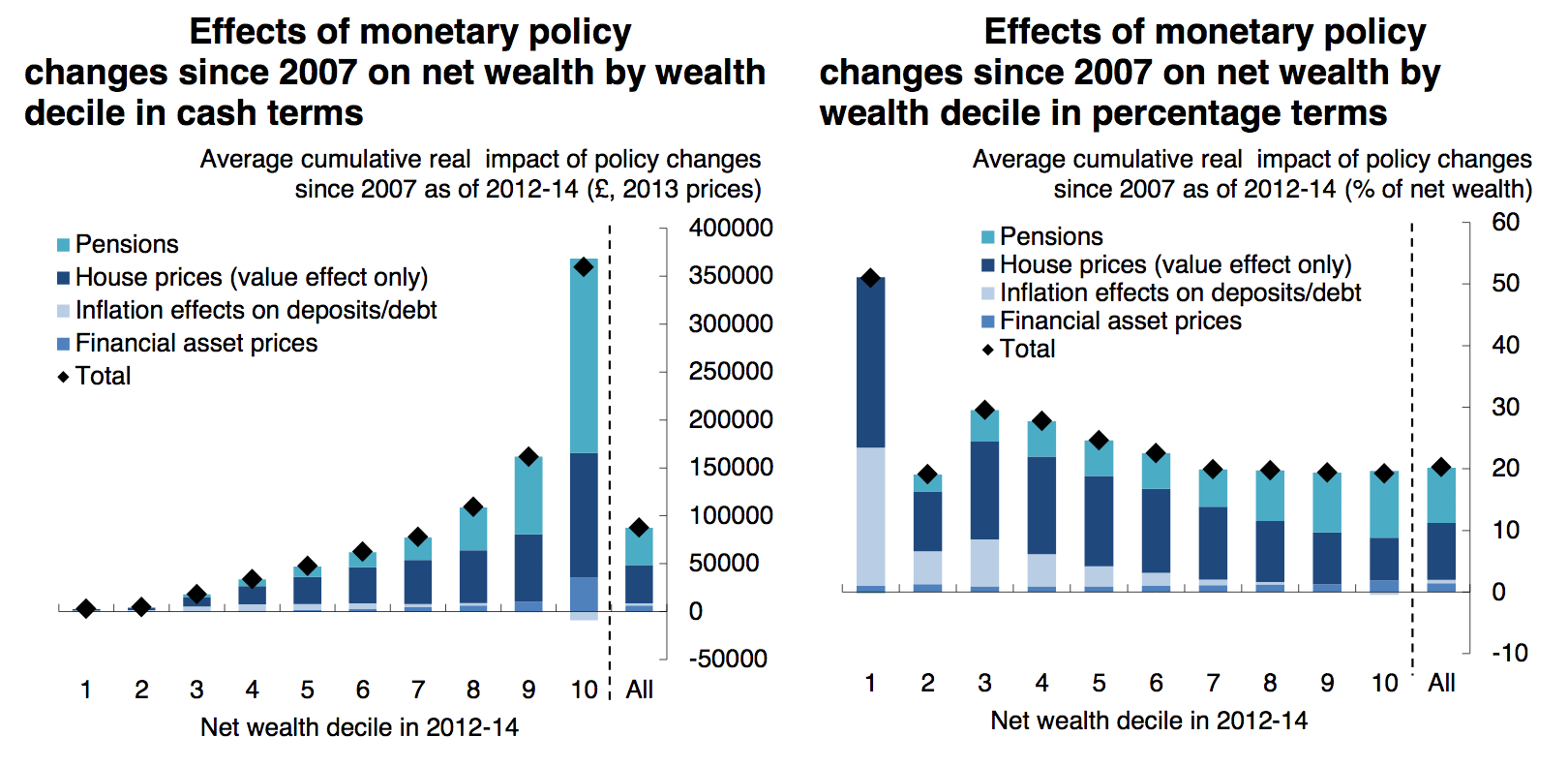
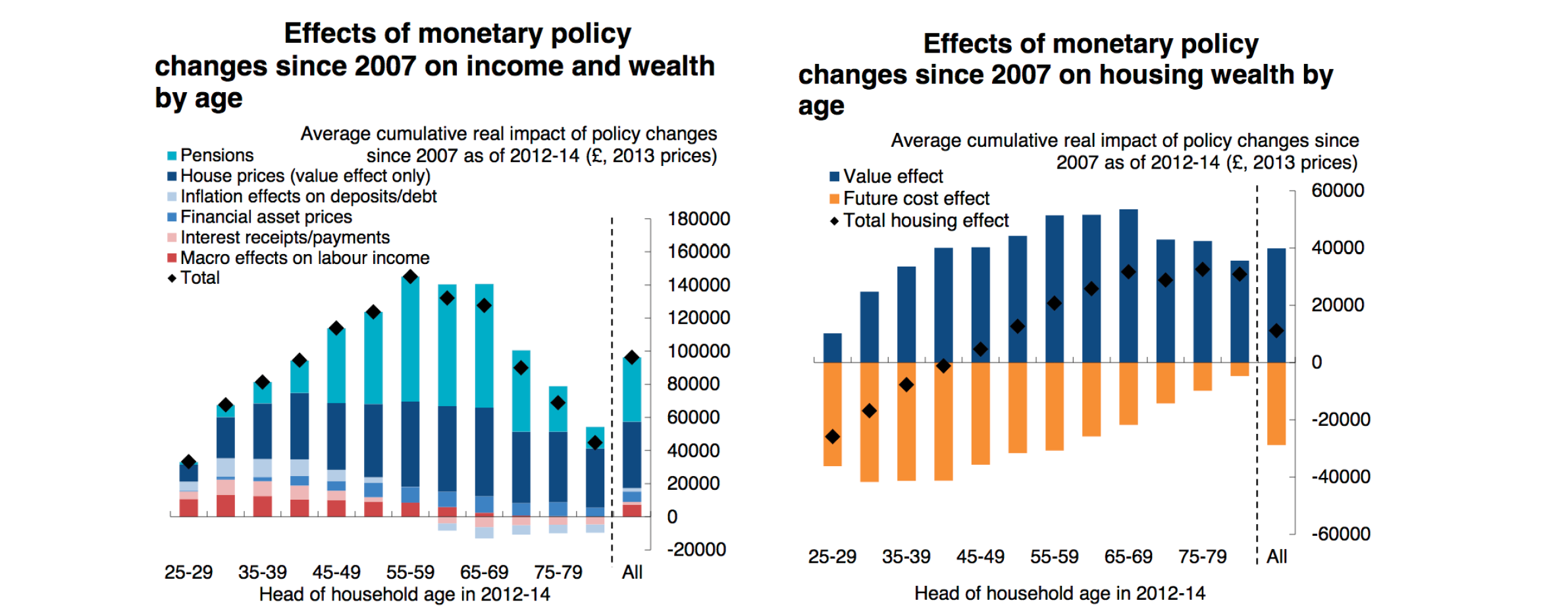
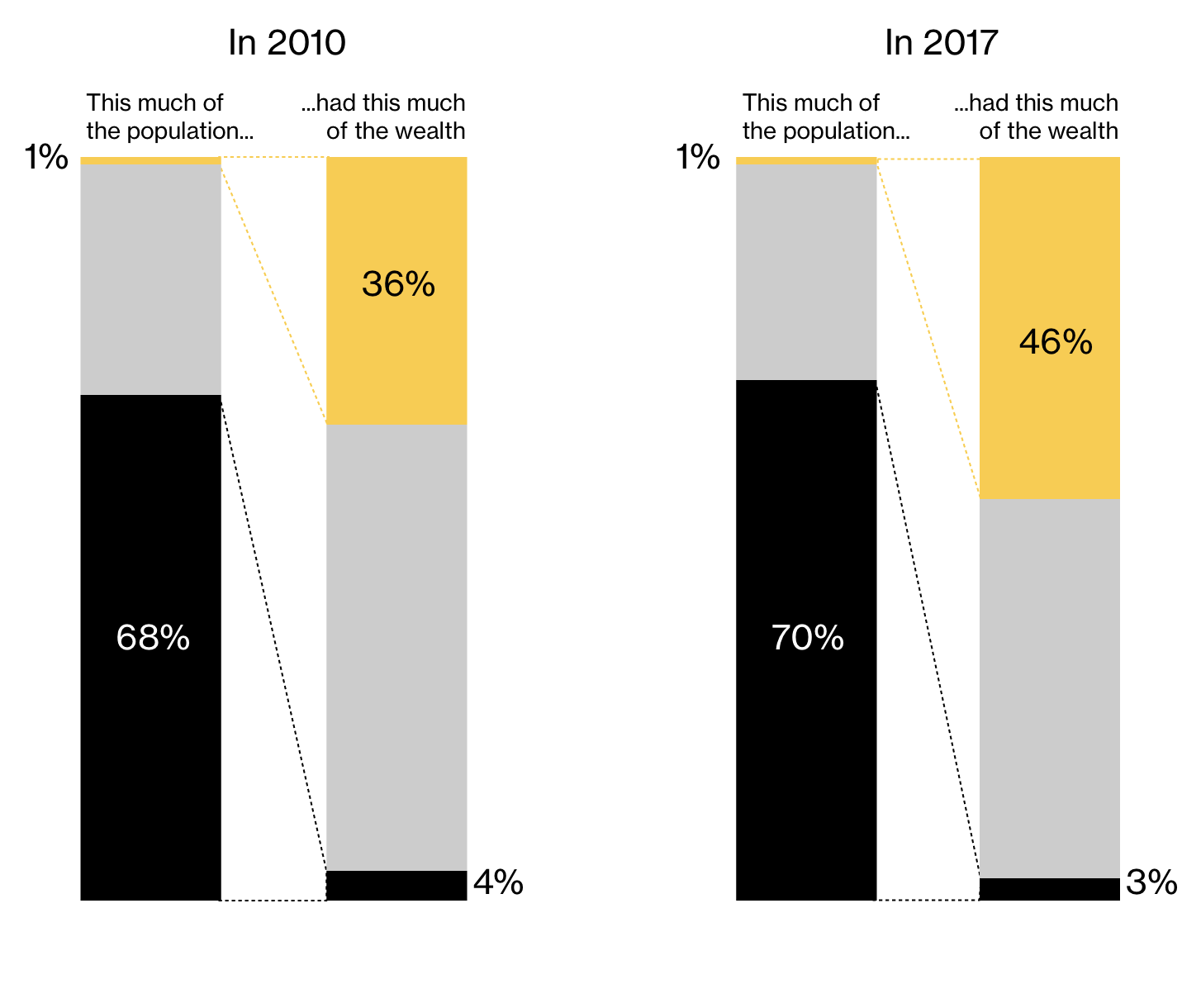
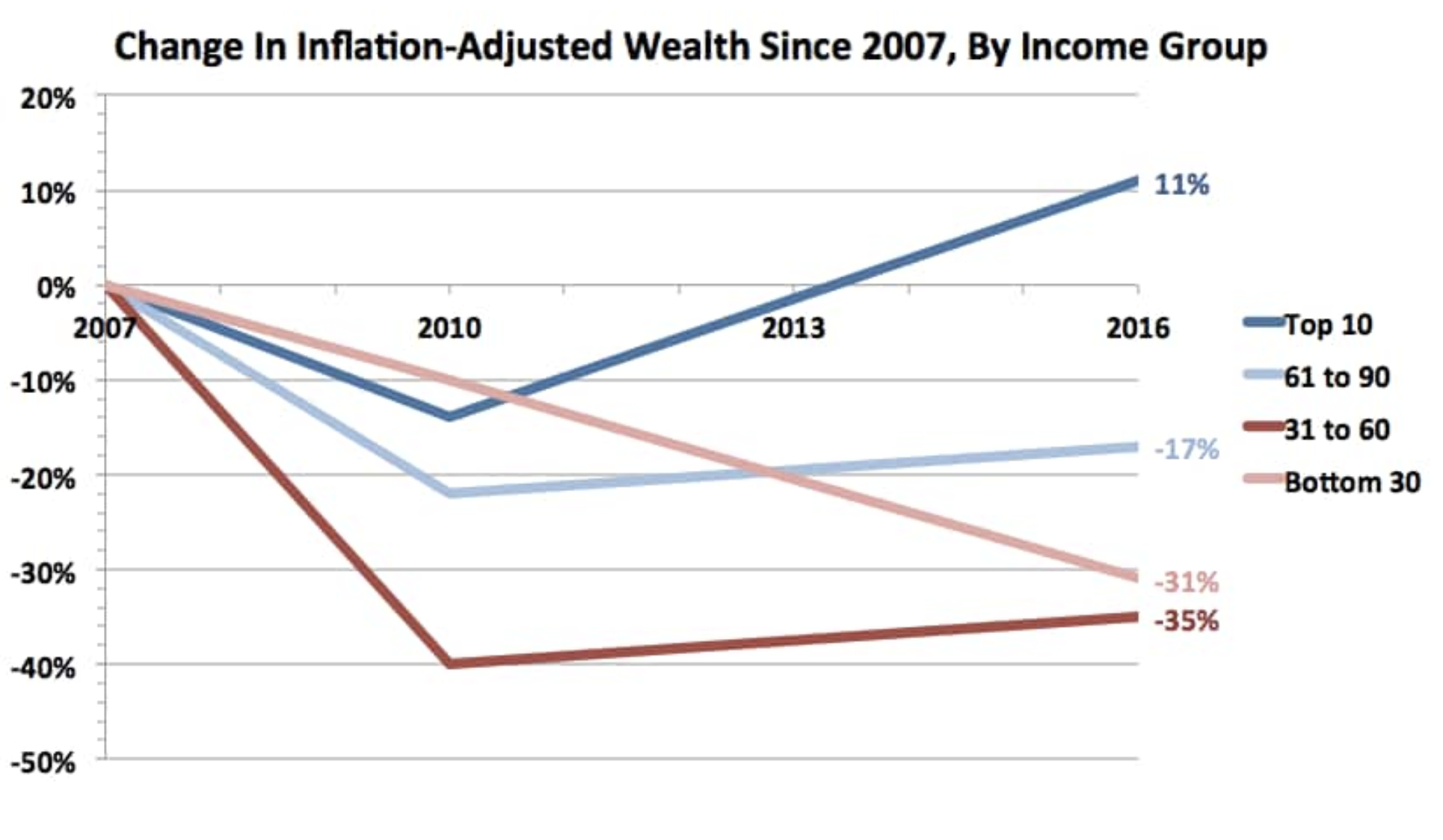
WORLD WEALTH CONCENTRATION
One has to be clear though. This worsening of inequalities was not intended by central banks, nor did they have much choice given the financial crisis. The BOE’s study finds that the counterfactual scenario, in which central banks did not intervene, would have left all groups worse off. If inequality is reduced because all households are growing poorer, that’s not a happy outcome either. But QE clearly still has profound and highly disturbing social effects.
In a well-functioning economy, wealth rewards positive economic contributions and is not an arbitrary, monetary-induced phenomenon. A large, disenfranchised electorate has been a key supporter of populist and anti-establishment candidates from the U.S. to Britain to Italy and France. This is not a temporary anomaly, for trust in the fairness of the system has been fundamentally shaken, with a majority now believing the economy is “rigged.” They will continue to clamor for change CNN.
This attempt to deflect responsibility for measures that had to be taken in crisis, but that may well have been prolonged unduly, is somewhat surprising. The U.S. is having, as usual when it comes to wealth, a much more honest debate about this. First, there is no denial that monetary policy affected wealth distribution. Indeed, Bernanke has argued that “the distributional impact of monetary policy should not prevent the Fed from pursuing its mandate to achieve maximum employment and price stability.” And QE, beyond the liquidity injection, relies on the wealth effect – which causes people to spend more when they see their assets appreciate – and its potential trickling down. To quote Business Insider: “One of the key channels by which quantitative easing works is through the wealth effect. With the central bank suppressing interest rates, investors are pushed into riskier assets, lifting the value of those assets. This, in turn, makes households feel wealthier, encouraging individual spenders to increase consumption.” All good in theory, but as Warren Buffet concluded, in fact, “The tsunami of wealth effect didn’t trickle down. It surged upward.”
This has understandably raised profound fairness questions. Why would the central banks be authorized to use their “public good” monetary power to make the wealthy – who overwhelmingly own the stocks and securities benefiting in price from QE – wealthier? Former Fed board member Kevin Warsh explains that QE works as an “asset price channel” that enriches a small group of stock owners and not the majority of working people. Reviewing the many studies and conferences on the topic, Forbes concluded, “International data show wealth inequality is falling globally, but not within developed countries with quantitative easing programs.” Brookings Forbes
QE is not the Schumpeterian wealth creation by entrepreneurs being rewarded with the benefits trickling down to all of society. It is in fact a distorted and arbitrary magnification of the status quo, the very opposite of the social mobility that justifies the need for income differences. Increased wealth inequality then becomes not only economically but politically unacceptable and unsustainable. Critically, QE has enhanced inequality in a blatantly unfair manner, at precisely the time the exasperated lower and middle classes had been subject to decades of stagnant wage growth and worsening budget strains. Some politicians realize it. “While monetary policy with super low rates and quantitative easing have provided emergency medicine, we have to acknowledge some of the bad side effects. People with assets have got richer, while people without have not,” U.K. Prime Minister Theresa May said at a Conservative party conference. Either way, QE’s stark social consequences have elevated the populist agenda tremendously.
QE’S REAL WINNER
When he accelerated QE in 2015 during the sovereign spread crisis, the ECB chairman, Mario Draghi, vehemently denied that the ECB was blessing a kind of “monetary financing.” That practice, forbidden under EU treaty rules, refers to the financing of government expenditure directly through money creation. From a legal standpoint, Draghi was technically correct, but more on account of semantics86 than substance.
The argument that this doesn’t constitute monetary financing ignores the fungible nature of government bonds in the securities market. If a national central bank acquires a quarter of its country’s national debt, the state no longer has to find buyers for that debt.
Further, if a national central bank states that it will keep this money invested in government bonds in the future, as has just been done by the ECB87 under its new Principal Reinvestment Policy, the debt purchased has effectively been monetized for the foreseeable future, which is exactly what monetary financing is. The same is true in the U.S. or in Japan. In Europe, QE has brought massive money creation and the ensuing seigniorage tax,88 without materially boosting private sector activity or financing any fiscal stimulus beyond interest rate reductions. This stands in sharp contrast to the U.S., where monetary policy indirectly financed a fiscal stimulus, boosting demand and triggering a recovery. Forbes
In order to prevent monetary financing and seigniorage, public accounting rules separate state-owned but independently managed central banks from government accounts. Then, the theory goes, the independent central bank will not be forced to finance government spending by either directly printing money or, indirectly, by systematically purchasing the bonds issued by the government to finance its spending. But from a consolidated point of view, not only has QE enriched the richest, it was a massive bond purchase by the central banks. It can thus be understood as a large seigniorage tax on the middle class, fixed-income pensioners in particular. QE policy has thus accentuated wealth disparities, enriching the wealthiest, taxing the middle class, and dramatically reducing the net debt of governments.89
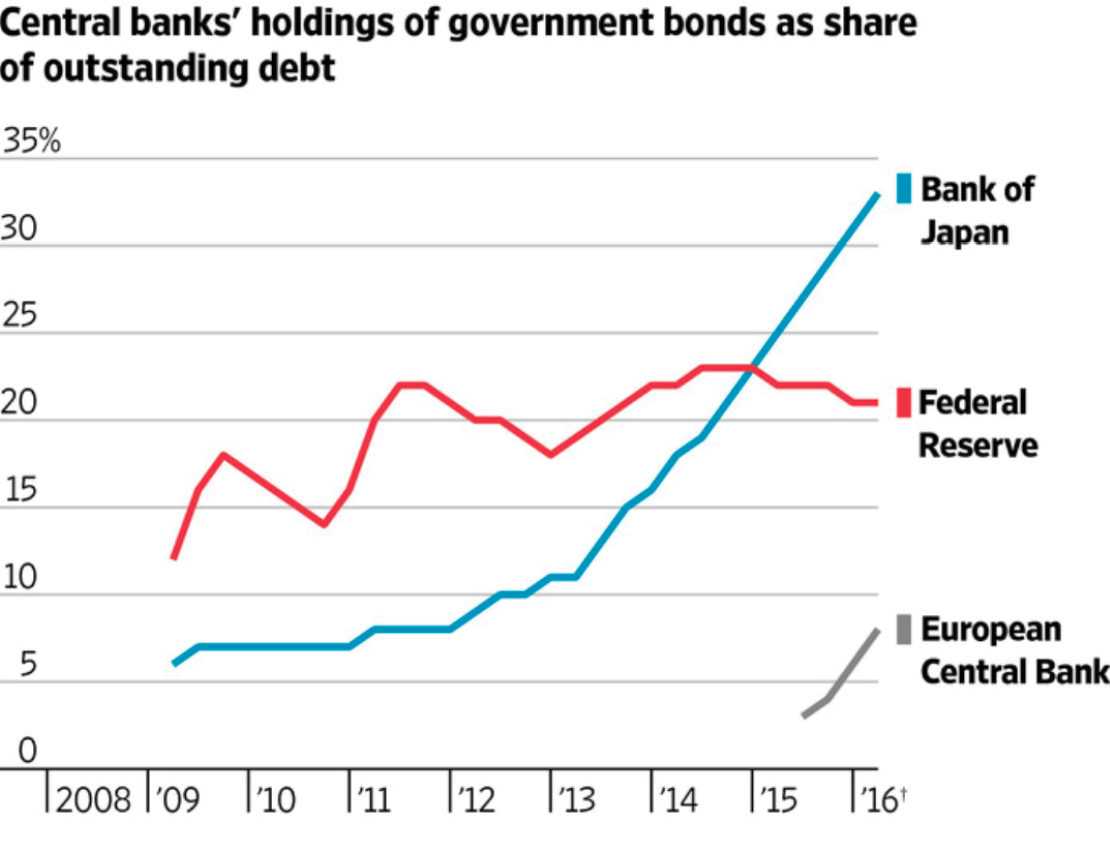
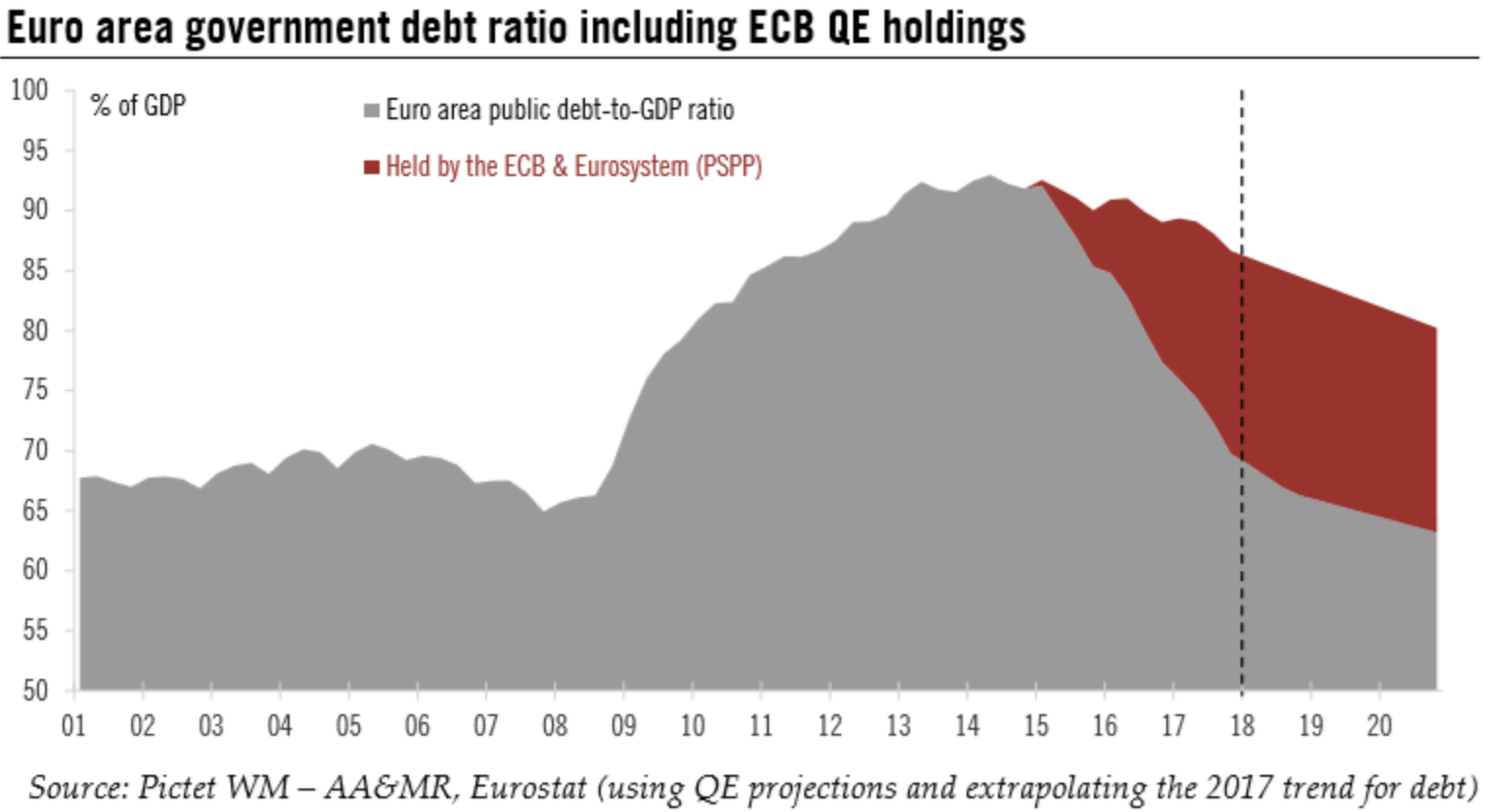
MONEY FOR NOTHING AND TROUBLES FOR FREE
Low interest rates induced by QE may have boosted the economy in the short term, propelled sky-high financial valuations and subsidized indebted governments. But QE never – contrary to some expectations and claims by central bankers – spurred any significant consumer price inflation. At the outset, the expectation was that QE would eventually create an unacceptable level of inflation, at which point the central banks would wind it down. After 10 years, that has shown no signs of happening yet central bankers are still using inflation as a measure to know how much more QE they should proceed with. As the other negative side effects of QE pile up, bankers are largely ignoring those symptoms as they wait for inflation to rise. This has been a recipe for QE overdose.
Additionally, QE has created real economic harm by encouraging poor decision-making among corporations. The policy’s prolonged distortion of interest rates, a key economic indicator, has put us in dire straits. It has been sending for over a decade an improper price signal to all economic decision makers. As a result, erroneous decision-making in the real economy has been increasing. Too low interest rates have pushed already over-indebted companies into making increasingly leveraged transactions. Simultaneously, the low interest rate is affecting the banks that QE was supposed to save by reducing banks’ interest income. Evidence of these misallocations abound and will take a heavy toll, with credit default rates increasing, while financial institutions have been unable to restore and replenish their capital base.
The resulting disequilibrium is real and harming our long-term growth prospects beyond a cyclical recovery. It has brought back excessive real estate prices. It has incentivized M&A activity motivated by financial wizardry rather than real synergies. And it has kept alive economically moribund zombie companies, which suck resources from the economy rather than give way to creative destruction. All this has resulted in financial bubbles abounding in a grossly overleveraged economy. These financial time bombs will leave us in a precarious position as the next recession approaches. When the bubbles correct, the central banks will have little room to further lower interest rate. To make an analogy, central banks acted to address a heart attack of the financial system, but by prolonging the dangerous medicine far too long, they have generated a deadly cancer.
QE’S EFFECT ON BANKS
Banks are inherently duration transformation engines, making long-term loans out of short-term deposits. Steadily lower interest rates mechanically hurt their profitability, because banks make money by charging interest. Central banks have inflated asset prices through QE purchases. This created money as these financial assets were “monetized,” and led to a broadened money base from 2009 to today. But this newly created money was stored rather than lent – the opposite of a transformation engine role.
As a result, the velocity of money fell. Money velocity is a key economic indicator that measures how a currency is being used, and thus its impact on prices and growth. Because velocity fell, inflation did not rise, despite the larger money supply. We remain in an unsettled economic situation, with more money on our hands – often literally, in the form of cash holdings or short-term deposits.90
Critically, according to a recent paper from the BIS, loose monetary policy does not affect bank profitability equally in all environments. It turns out that when initial interest rates are already low, loose monetary policy does greater harm to bank profits than it does when initial interest rates are high. In other words, the negative effects are not linear, i.e., proportional. They are exponential. To quote the BIS: “These findings have implications for the possible unintended side effects of unusually accommodative monetary policy, designed to keep both short-term and long-term rates very low for very long periods.” Not surprisingly, when looking at European banks, a much stronger correlation is found between low profitability and the yield curve than is found between low profitability and the level of outstanding non-performing loans.
The BIS findings imply that the QE program particularly affects the profitability of financial sectors in fiscally sound countries. If this policy were to be prolonged much further, it would undoubtedly create the basis for a major banking crisis in these countries. The recent difficulties of some European banks, with a few Italian banks already having to be rescued, reveal just how much stress QE has imposed on them and is foretelling what will happen in the next crisis.
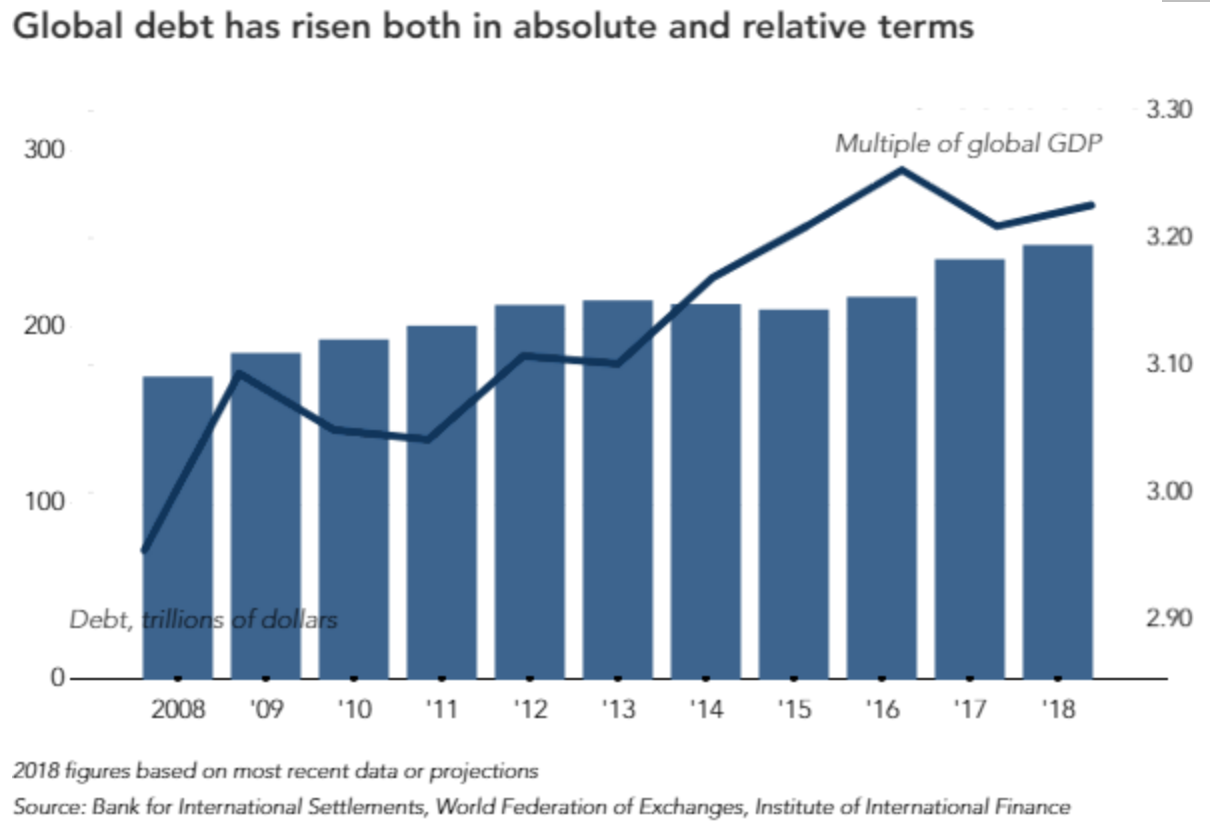
BAD CREDIT
Historically low interest rates have not only allowed zombie companies to avoid default, but they have also increased leverage across the board. According to the BIS, advanced economies now have total debt in excess of 250% of GDP. In these conditions, credit spreads should have tightened, but desperate bondholders, eager for yield and sometimes competing with the central banks, have disregarded growing credit risk. In normal times, sudden unexpected recent bankruptcies would typically awaken the credit market vigilantes. With QE money overflowing, credit spreads have remained abnormally low, encouraging ever-increasing stakes in an increasingly risky, and less-and-less rewarding bet for debt holders. Morningstar summarized the situation bluntly, warning, “Not only are credit spreads tighter now than in much of the recent past, but the average credit quality of the Morningstar Corporate Bond Index is lower than it was much of the time” Morningstar.
With access to more and cheaper debt, but relatively limited organic growth opportunities, companies have started embarking on an M&A spending spree. Competing fiercely for limited targets, they have offered ever higher valuations, with multiples of enterprise values on EBITDA now similar to those observed just before the financial crisis91. As the economic cycle unfolds, as the Fed attempts to ‘taper’ QE, postposed yet inevitable corrections will take place. Many of these deals will ultimately generate significant losses.
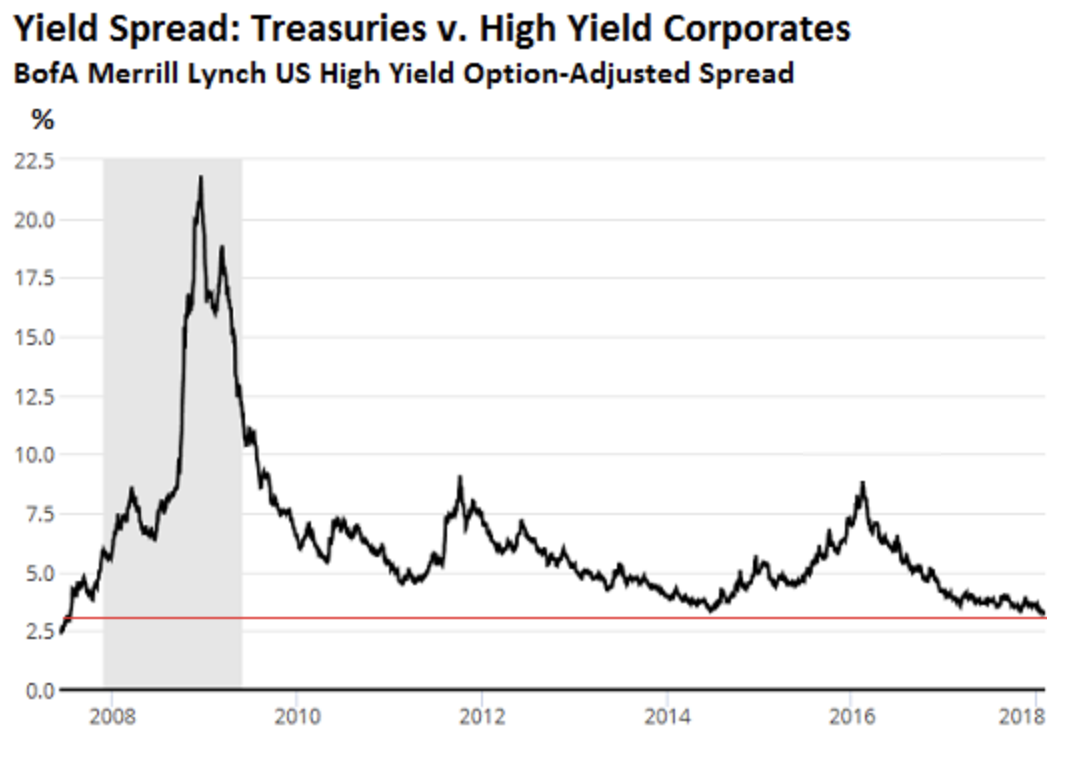
BAD INVESTMENT, OVERVALUATION
Private Equity might well become the posterchild of the next economic crisis. Yield hungry investors, enriched and starved simultaneously by QE, have flooded to this asset class. Unable to profitably and rationally invest, these firms have built up the largest level of “dry powder” on record, in excess of half a trillion dollars. Private equity managers, rewarded on performance, are on a hot seat. This money is burning their pockets, pushing them into ever more perilous investments92, which could easily turn into heavy losses.
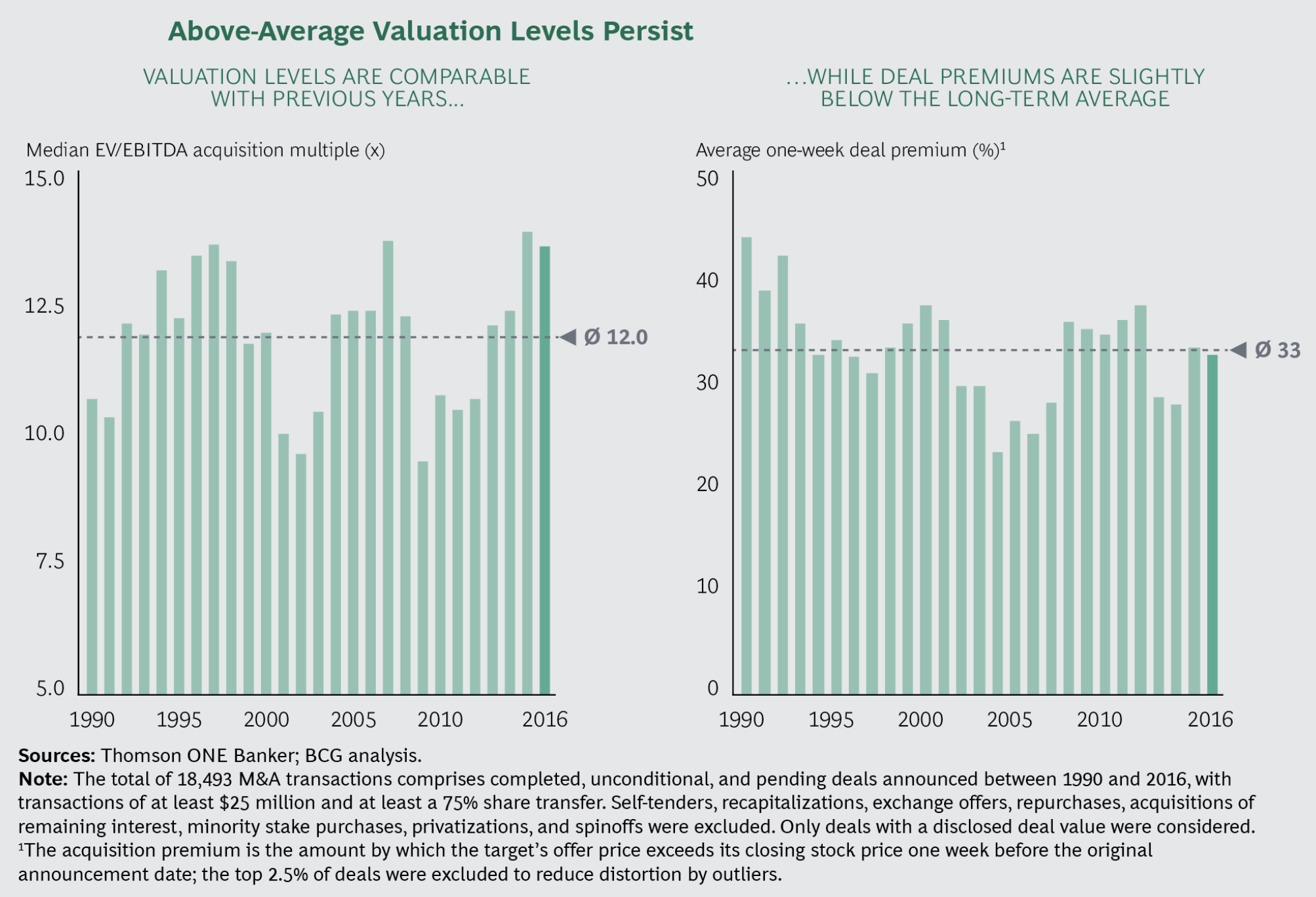
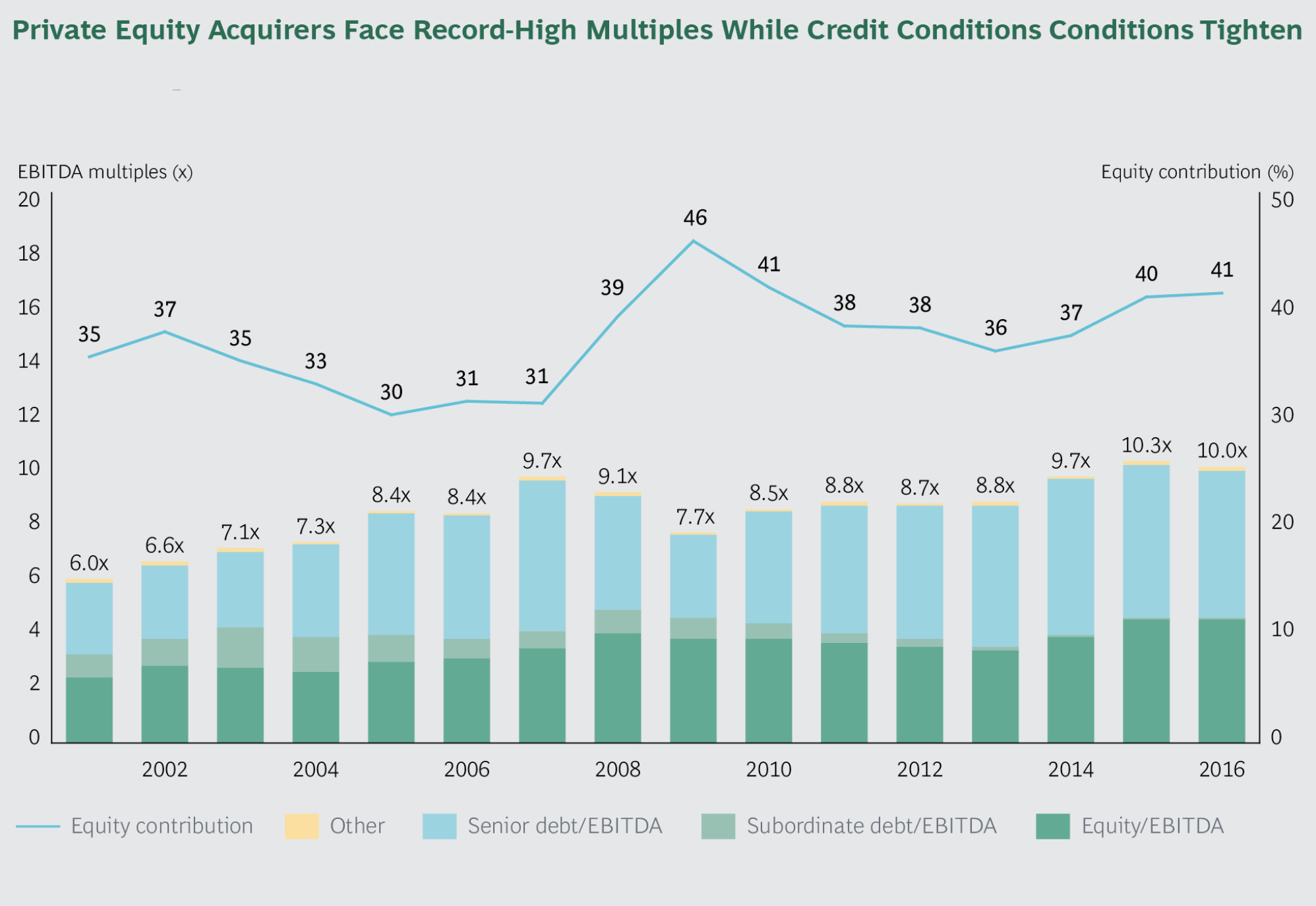
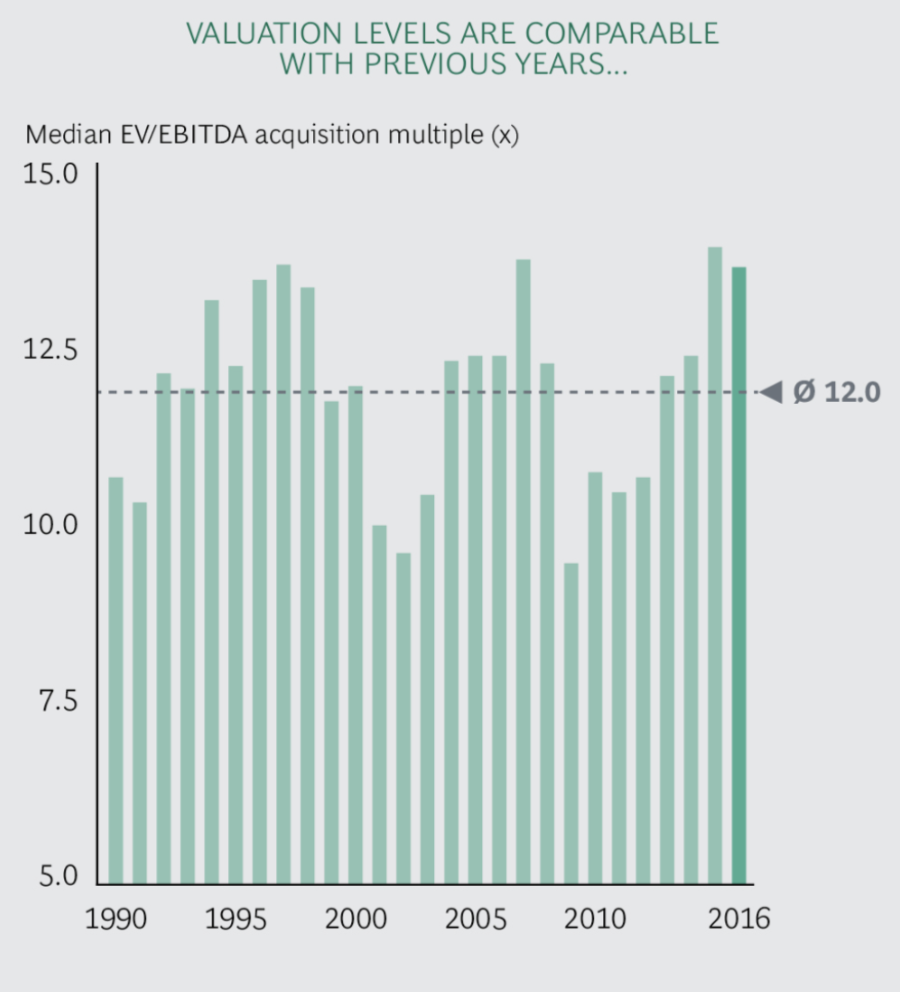
WRONG PRICE, WRONG SIGNALING AND WRONG DECISIONS
QE has for a prolonged time corrupted the economic signals upon which economic actors make decisions. This is true for investment, but goes far beyond and will ultimately prove very costly.
Consider the price paid for insurance. In 2017, the largest insurance losses on record were recorded, exceeding $300 billion. Typically, after large cyclical losses, insurance premiums enter what is known as a “hard market.” Premiums increase, enabling insurance companies to rebuild their capital reserves. Simultaneously, the insurance companies, now capital constrained, enter into an enhanced and revised risk exposure selection as well as a repricing of the insured risks.
This is not what has happened. Following a brief period when the catastrophe bond spreads widened, the market returned to historically low premiums. This has been driven by QE yield starved investors flush with money entering the market. New issuances were grabbed as if nothing had happened.93
As a fund manager in catastrophe bonds insurance products, I had to recognize this trend. Simply put, the risks were no longer worth insuring. Continuing would have been to bet on catastrophes no longer happening as historically known, rather than to believe that on average it was a profitable activity. That is something you can do only if you are satisfied with, “tails I win, heads somebody else loses.” As a result, I had to close down a fund which had a strong track record and positive historical performance.
The bypassing of the natural insurance cycle can have serious consequences. Low insurance premiums increase adverse selection by insureds that are able to shift their risks onto insurers at ever lower rates. The insured benefiting from subsidized insurance premiums will not take the steps needed to prevent and limit damage from future catastrophes. Insurance companies will not have the opportunity to replenish their reserves. All that translates into higher risk taking and a more fragile sector.
Manipulating money and interest rates, as QE did, is a dangerous game. It corrupts valuation and economic signals. It may well be necessary in the middle of a financial crisis, but the more prolonged the distortion, the more it is bound to come back in devious, profound, and unexpected ways. Wherever you look, the distorted signals sent by central bank actions appear to have fomented “irrational exuberance” reminiscent of the worst episodes of the dot com bubble. The next crisis is coming and painful yet necessary corrections are unavoidable. Prolonging distorted signaling will only make those corrections more destructive when they do arrive.
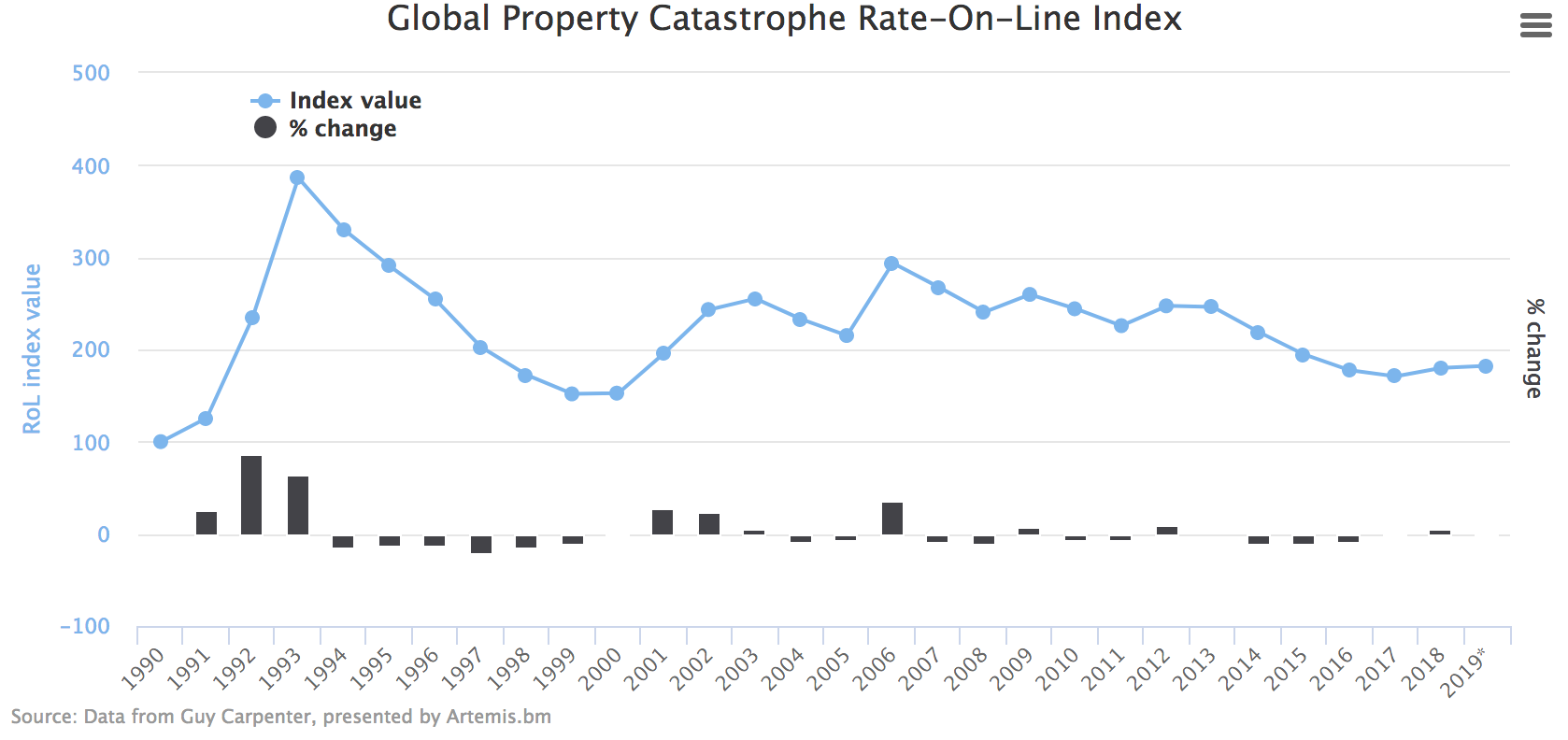
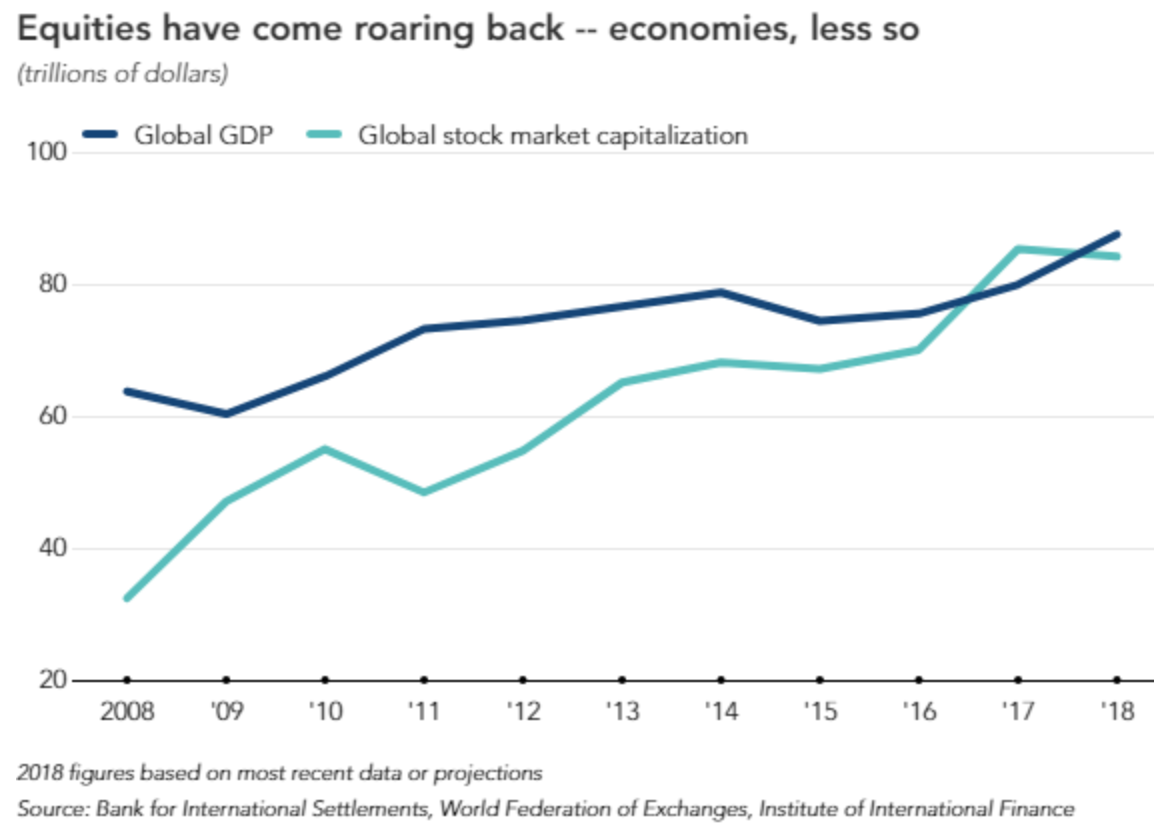
(DIS)TRUST IN MONEY
As money issuance continued beyond the first round of emergency QE, trust in financial products started eroding. Investors began seeking a “safe haven” in “real assets,” be they real estate or commodities. Thus, a spill-over effect of QE has been increased real estate prices, not only because of the lower cost of servicing the associated debt, but because of the perceived safety of that kind of “real” investment.
Simultaneously, a distinctive social trend of disbelief, and distrust of fiat money, linked to general distrust of societal institutions, has developed. A cohesive society and money are after all linked, since money is little more than a collective delusion by and for the people. People began searching for alternative currencies that were not subject to the “whims” of central banks. There was a renewed and intense interest in developing cryptocurrency, leading to bubbles.
Indeed, one of Bitcoin’s selling points was that the amount of it in circulation is limited and cannot be increased. In that sense it was likened to a new, digital gold, because of its externally set and finite supply. Unsurprisingly, central banks and finance ministries clamped down with regulatory interventions on this unwelcome challenge to their money-issuing monopolies. But the warning message contained in the crypto craze is clear. QE has eroded the social contract around which money is based, it has fundamentally affected people’s confidence in the common monetary instrument. Continued abuse of the money printing monopoly by central banks could lead not only to market distortions but to growing defiance of central banks’ control of money issuance. This is a threat to “the supreme prerogative of government,” as Abraham Lincoln called monetary control.
AFTER QE
Issuing money is addictive. Ten years after the financial crisis, the U.S. has just started tapering, and other central banks slowing down, QE. Policy makers, faced with weak and dependent economies hooked on QE delay the necessary steps. But QE market distortions are becoming ever more blatant. The economic damage created by QE’s extended misallocation of resources will eventually have to be unwound. Yet governments and central banks have failed to use the breathing room they have bought. They failed to come up with a bold vision and a strong public investment program in infrastructure and human capital that could have truly rebooted demand.
The next recession is coming. It will come with a larger asset bubble than ever before, with seemingly no room for fiscal policy, and no sustainable room for monetary policy. Any additional QE may well completely erode confidence in the monetary and political system, while tapering could well foment the next crisis by triggering an asset correction, as recently seen.
We thus find ourselves at a critical juncture. The central bankers now bear an awesome responsibility. If, in their ivory towers, they ignore the political impact of the measures they have taken, continue to whitewash the social distortions caused by their once necessary intervention, and stubbornly continue sterile debates on outdated economic models based on indicators ill-suited to the new economic paradigm, they will exacerbate a politically volatile situation. They would like to continue to play for time, hoping for a prolonged cyclical recovery or the continued boost of a weakening currency, but are quietly fearing an approaching crisis for which they know we are unprepared.